Foreign Exchange Rates and Quantitative Easing: Impact on Global Economy
VerifiedAdded on 2023/06/13
|21
|4735
|277
AI Summary
This article discusses the impact of foreign exchange rates and quantitative easing on the global economy. It covers topics such as demand and supply of currency, interest rates, the global financial crisis, and the impact of quantitative easing on China.
Contribute Materials
Your contribution can guide someone’s learning journey. Share your
documents today.
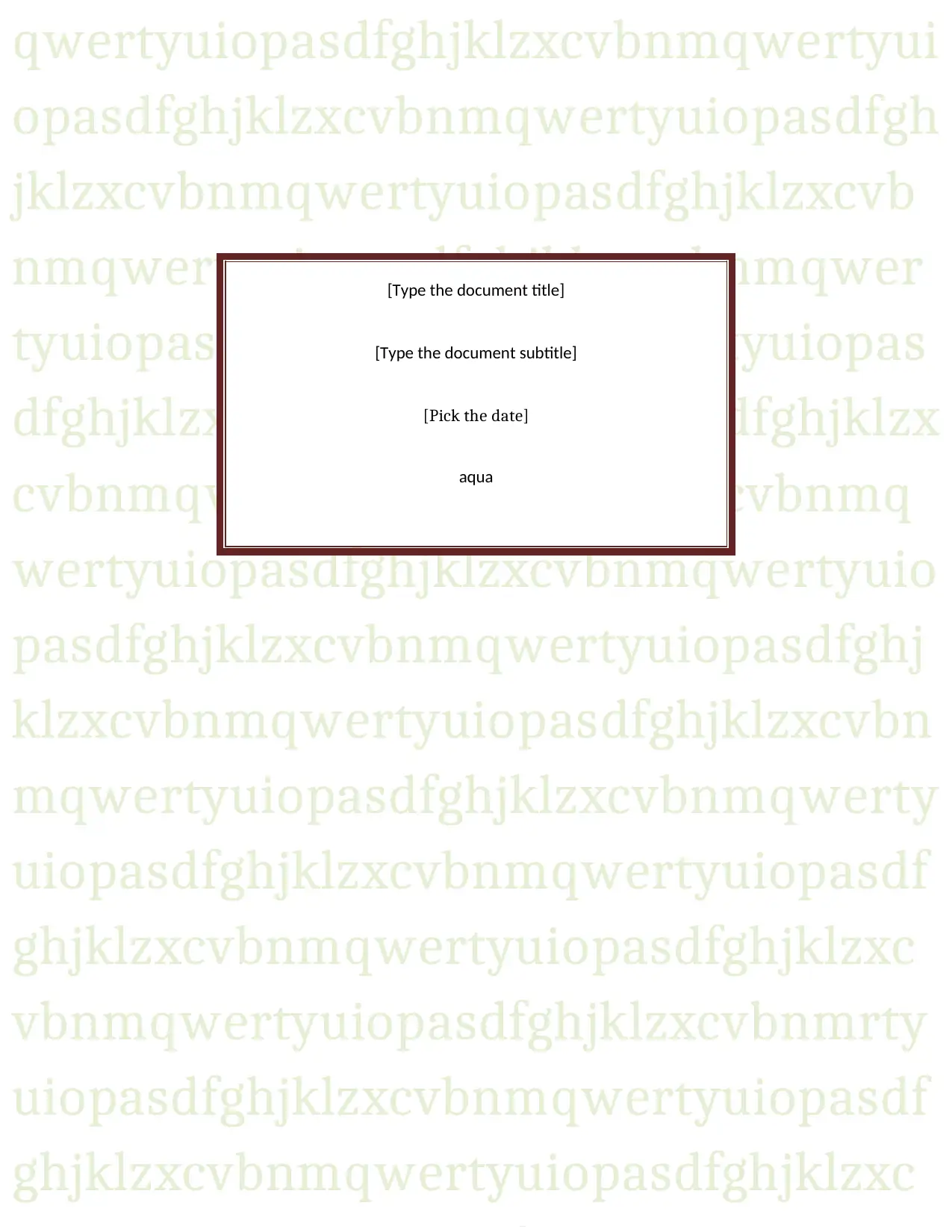
qwertyuiopasdfghjklzxcvbnmqwertyui
opasdfghjklzxcvbnmqwertyuiopasdfgh
jklzxcvbnmqwertyuiopasdfghjklzxcvb
nmqwertyuiopasdfghjklzxcvbnmqwer
tyuiopasdfghjklzxcvbnmqwertyuiopas
dfghjklzxcvbnmqwertyuiopasdfghjklzx
cvbnmqwertyuiopasdfghjklzxcvbnmq
wertyuiopasdfghjklzxcvbnmqwertyuio
pasdfghjklzxcvbnmqwertyuiopasdfghj
klzxcvbnmqwertyuiopasdfghjklzxcvbn
mqwertyuiopasdfghjklzxcvbnmqwerty
uiopasdfghjklzxcvbnmqwertyuiopasdf
ghjklzxcvbnmqwertyuiopasdfghjklzxc
vbnmqwertyuiopasdfghjklzxcvbnmrty
uiopasdfghjklzxcvbnmqwertyuiopasdf
ghjklzxcvbnmqwertyuiopasdfghjklzxc
[Type the document title]
[Type the document subtitle]
[Pick the date]
aqua
opasdfghjklzxcvbnmqwertyuiopasdfgh
jklzxcvbnmqwertyuiopasdfghjklzxcvb
nmqwertyuiopasdfghjklzxcvbnmqwer
tyuiopasdfghjklzxcvbnmqwertyuiopas
dfghjklzxcvbnmqwertyuiopasdfghjklzx
cvbnmqwertyuiopasdfghjklzxcvbnmq
wertyuiopasdfghjklzxcvbnmqwertyuio
pasdfghjklzxcvbnmqwertyuiopasdfghj
klzxcvbnmqwertyuiopasdfghjklzxcvbn
mqwertyuiopasdfghjklzxcvbnmqwerty
uiopasdfghjklzxcvbnmqwertyuiopasdf
ghjklzxcvbnmqwertyuiopasdfghjklzxc
vbnmqwertyuiopasdfghjklzxcvbnmrty
uiopasdfghjklzxcvbnmqwertyuiopasdf
ghjklzxcvbnmqwertyuiopasdfghjklzxc
[Type the document title]
[Type the document subtitle]
[Pick the date]
aqua
Secure Best Marks with AI Grader
Need help grading? Try our AI Grader for instant feedback on your assignments.
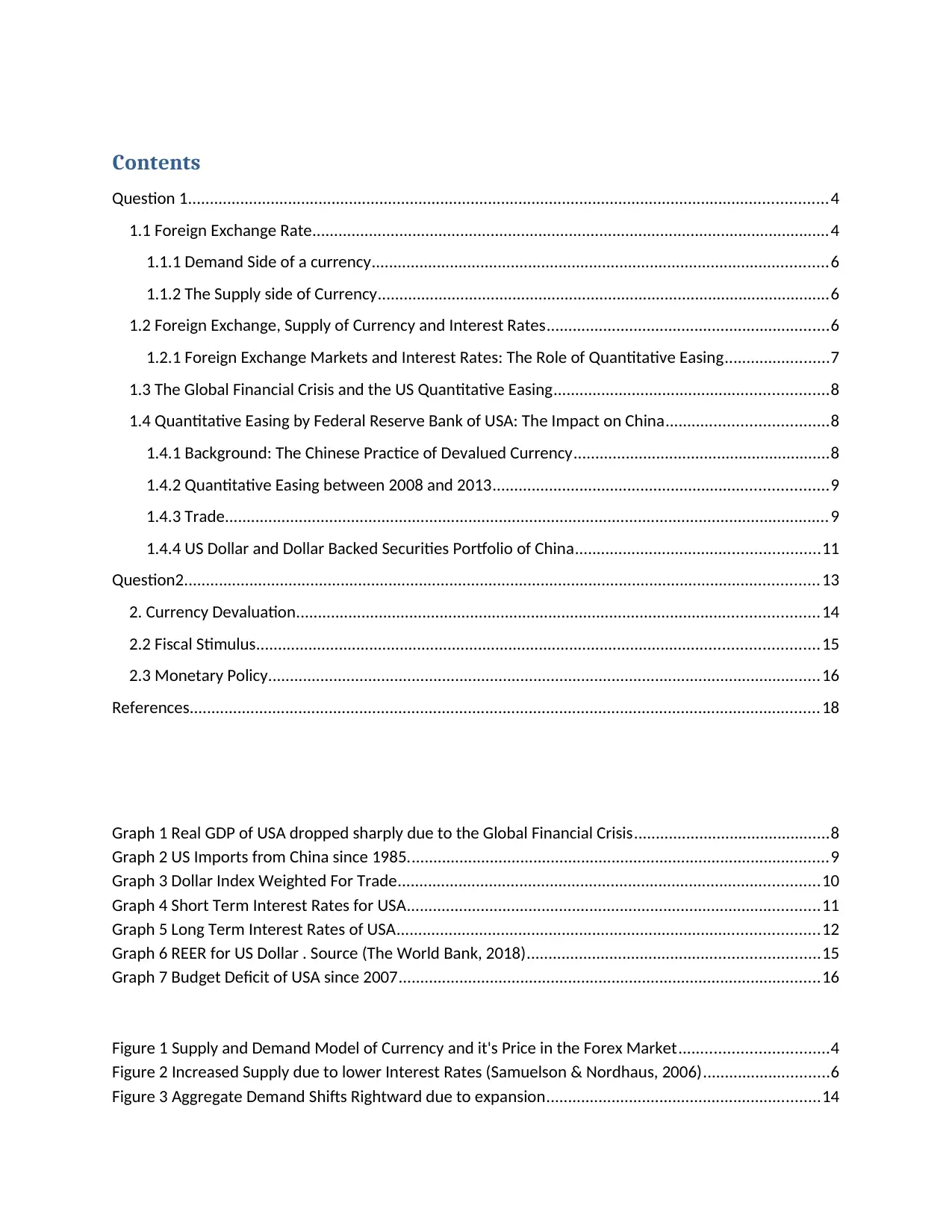
Contents
Question 1...................................................................................................................................................4
1.1 Foreign Exchange Rate.......................................................................................................................4
1.1.1 Demand Side of a currency.........................................................................................................6
1.1.2 The Supply side of Currency........................................................................................................6
1.2 Foreign Exchange, Supply of Currency and Interest Rates.................................................................6
1.2.1 Foreign Exchange Markets and Interest Rates: The Role of Quantitative Easing........................7
1.3 The Global Financial Crisis and the US Quantitative Easing...............................................................8
1.4 Quantitative Easing by Federal Reserve Bank of USA: The Impact on China.....................................8
1.4.1 Background: The Chinese Practice of Devalued Currency...........................................................8
1.4.2 Quantitative Easing between 2008 and 2013.............................................................................9
1.4.3 Trade...........................................................................................................................................9
1.4.4 US Dollar and Dollar Backed Securities Portfolio of China........................................................11
Question2..................................................................................................................................................13
2. Currency Devaluation........................................................................................................................14
2.2 Fiscal Stimulus.................................................................................................................................15
2.3 Monetary Policy...............................................................................................................................16
References.................................................................................................................................................18
Graph 1 Real GDP of USA dropped sharply due to the Global Financial Crisis.............................................8
Graph 2 US Imports from China since 1985.................................................................................................9
Graph 3 Dollar Index Weighted For Trade.................................................................................................10
Graph 4 Short Term Interest Rates for USA...............................................................................................11
Graph 5 Long Term Interest Rates of USA.................................................................................................12
Graph 6 REER for US Dollar . Source (The World Bank, 2018)...................................................................15
Graph 7 Budget Deficit of USA since 2007.................................................................................................16
Figure 1 Supply and Demand Model of Currency and it's Price in the Forex Market..................................4
Figure 2 Increased Supply due to lower Interest Rates (Samuelson & Nordhaus, 2006).............................6
Figure 3 Aggregate Demand Shifts Rightward due to expansion...............................................................14
Question 1...................................................................................................................................................4
1.1 Foreign Exchange Rate.......................................................................................................................4
1.1.1 Demand Side of a currency.........................................................................................................6
1.1.2 The Supply side of Currency........................................................................................................6
1.2 Foreign Exchange, Supply of Currency and Interest Rates.................................................................6
1.2.1 Foreign Exchange Markets and Interest Rates: The Role of Quantitative Easing........................7
1.3 The Global Financial Crisis and the US Quantitative Easing...............................................................8
1.4 Quantitative Easing by Federal Reserve Bank of USA: The Impact on China.....................................8
1.4.1 Background: The Chinese Practice of Devalued Currency...........................................................8
1.4.2 Quantitative Easing between 2008 and 2013.............................................................................9
1.4.3 Trade...........................................................................................................................................9
1.4.4 US Dollar and Dollar Backed Securities Portfolio of China........................................................11
Question2..................................................................................................................................................13
2. Currency Devaluation........................................................................................................................14
2.2 Fiscal Stimulus.................................................................................................................................15
2.3 Monetary Policy...............................................................................................................................16
References.................................................................................................................................................18
Graph 1 Real GDP of USA dropped sharply due to the Global Financial Crisis.............................................8
Graph 2 US Imports from China since 1985.................................................................................................9
Graph 3 Dollar Index Weighted For Trade.................................................................................................10
Graph 4 Short Term Interest Rates for USA...............................................................................................11
Graph 5 Long Term Interest Rates of USA.................................................................................................12
Graph 6 REER for US Dollar . Source (The World Bank, 2018)...................................................................15
Graph 7 Budget Deficit of USA since 2007.................................................................................................16
Figure 1 Supply and Demand Model of Currency and it's Price in the Forex Market..................................4
Figure 2 Increased Supply due to lower Interest Rates (Samuelson & Nordhaus, 2006).............................6
Figure 3 Aggregate Demand Shifts Rightward due to expansion...............................................................14
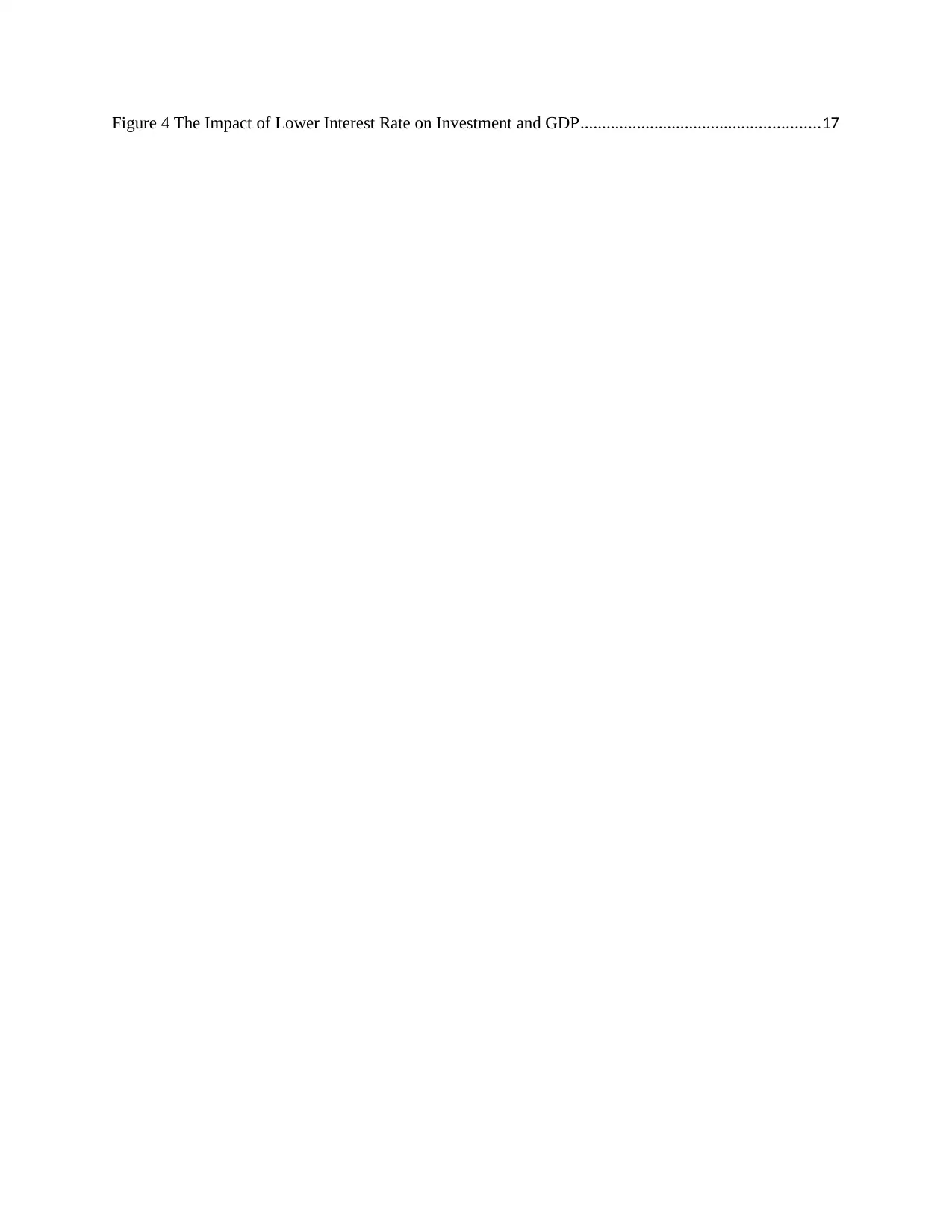
Figure 4 The Impact of Lower Interest Rate on Investment and GDP.......................................................17
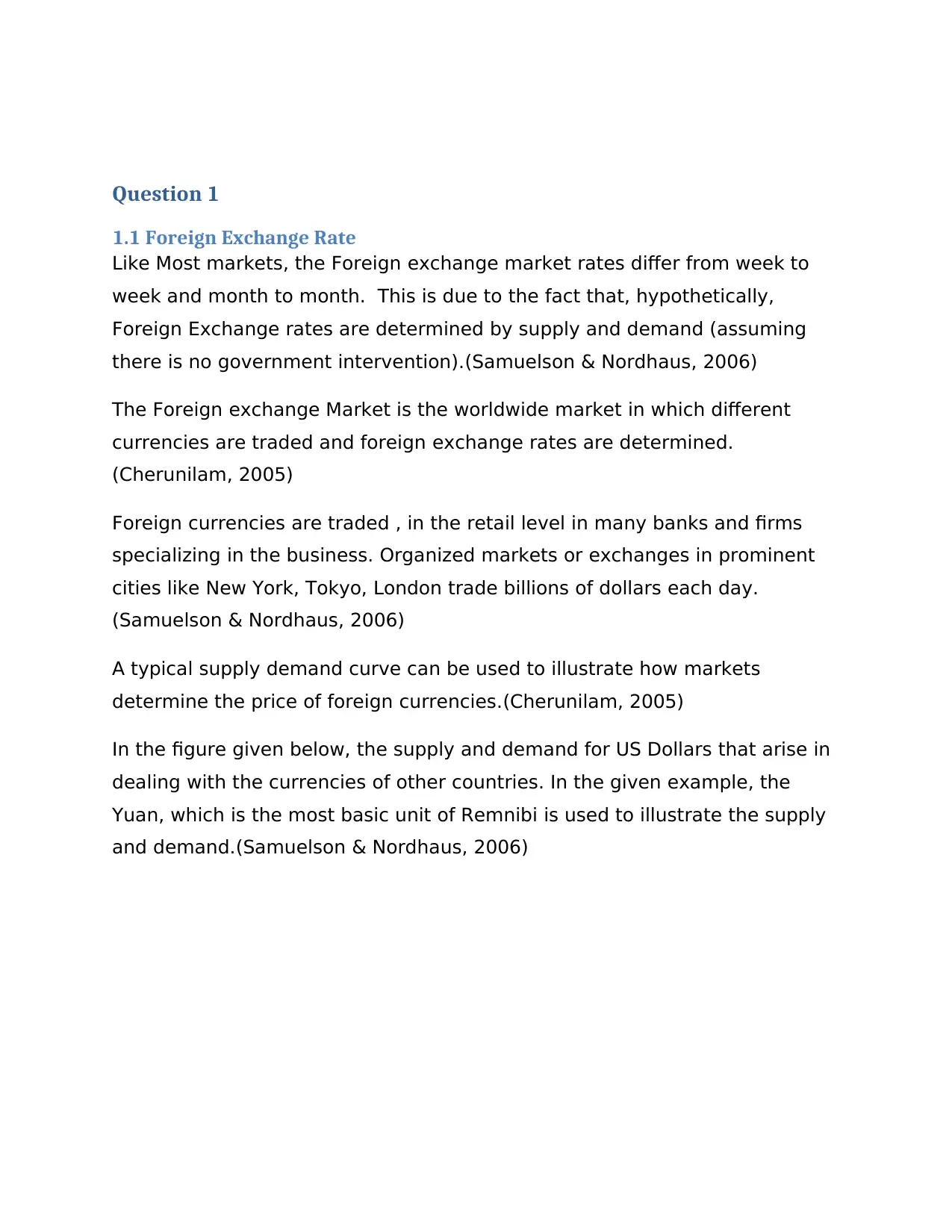
Question 1
1.1 Foreign Exchange Rate
Like Most markets, the Foreign exchange market rates differ from week to
week and month to month. This is due to the fact that, hypothetically,
Foreign Exchange rates are determined by supply and demand (assuming
there is no government intervention).(Samuelson & Nordhaus, 2006)
The Foreign exchange Market is the worldwide market in which different
currencies are traded and foreign exchange rates are determined.
(Cherunilam, 2005)
Foreign currencies are traded , in the retail level in many banks and firms
specializing in the business. Organized markets or exchanges in prominent
cities like New York, Tokyo, London trade billions of dollars each day.
(Samuelson & Nordhaus, 2006)
A typical supply demand curve can be used to illustrate how markets
determine the price of foreign currencies.(Cherunilam, 2005)
In the figure given below, the supply and demand for US Dollars that arise in
dealing with the currencies of other countries. In the given example, the
Yuan, which is the most basic unit of Remnibi is used to illustrate the supply
and demand.(Samuelson & Nordhaus, 2006)
1.1 Foreign Exchange Rate
Like Most markets, the Foreign exchange market rates differ from week to
week and month to month. This is due to the fact that, hypothetically,
Foreign Exchange rates are determined by supply and demand (assuming
there is no government intervention).(Samuelson & Nordhaus, 2006)
The Foreign exchange Market is the worldwide market in which different
currencies are traded and foreign exchange rates are determined.
(Cherunilam, 2005)
Foreign currencies are traded , in the retail level in many banks and firms
specializing in the business. Organized markets or exchanges in prominent
cities like New York, Tokyo, London trade billions of dollars each day.
(Samuelson & Nordhaus, 2006)
A typical supply demand curve can be used to illustrate how markets
determine the price of foreign currencies.(Cherunilam, 2005)
In the figure given below, the supply and demand for US Dollars that arise in
dealing with the currencies of other countries. In the given example, the
Yuan, which is the most basic unit of Remnibi is used to illustrate the supply
and demand.(Samuelson & Nordhaus, 2006)
Secure Best Marks with AI Grader
Need help grading? Try our AI Grader for instant feedback on your assignments.
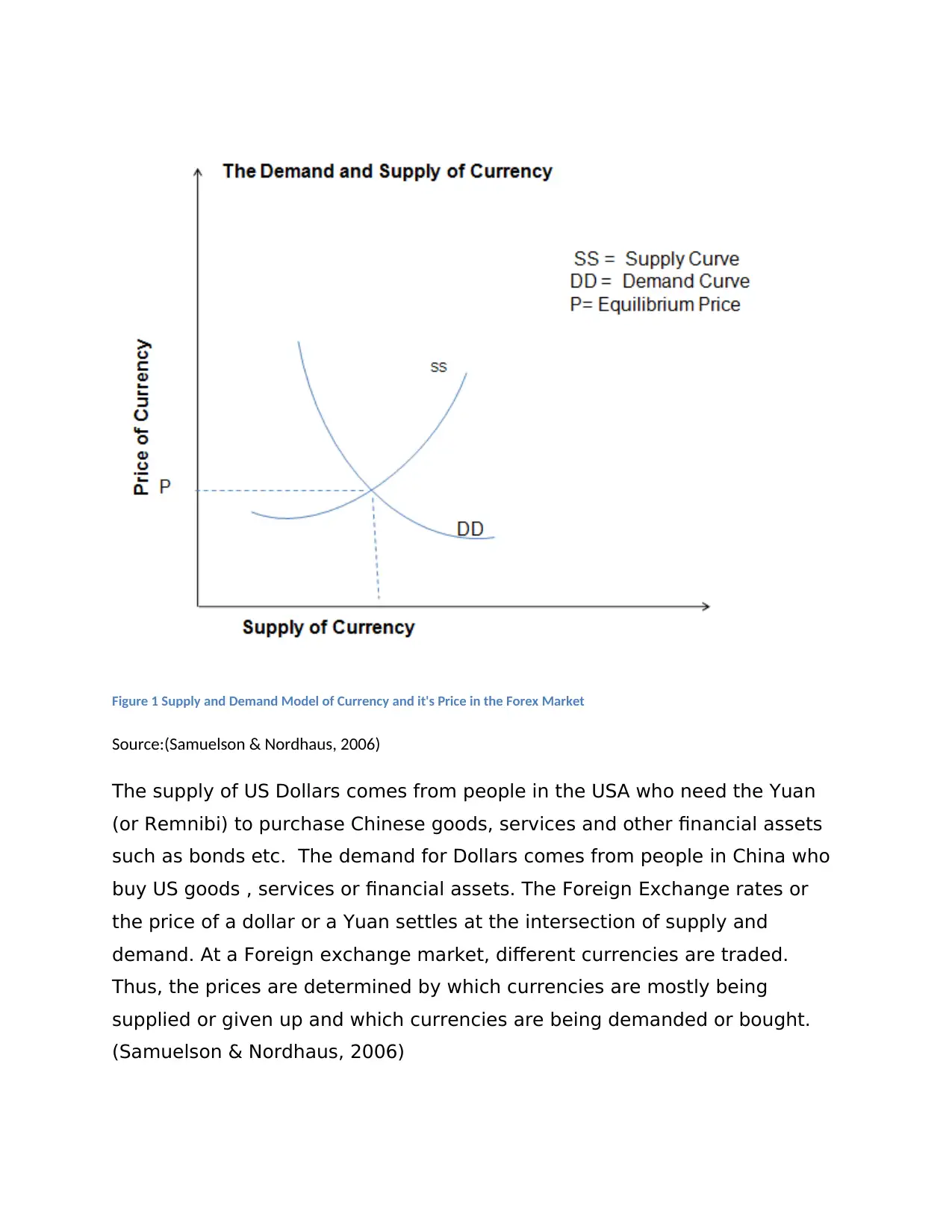
Figure 1 Supply and Demand Model of Currency and it's Price in the Forex Market
Source:(Samuelson & Nordhaus, 2006)
The supply of US Dollars comes from people in the USA who need the Yuan
(or Remnibi) to purchase Chinese goods, services and other financial assets
such as bonds etc. The demand for Dollars comes from people in China who
buy US goods , services or financial assets. The Foreign Exchange rates or
the price of a dollar or a Yuan settles at the intersection of supply and
demand. At a Foreign exchange market, different currencies are traded.
Thus, the prices are determined by which currencies are mostly being
supplied or given up and which currencies are being demanded or bought.
(Samuelson & Nordhaus, 2006)
Source:(Samuelson & Nordhaus, 2006)
The supply of US Dollars comes from people in the USA who need the Yuan
(or Remnibi) to purchase Chinese goods, services and other financial assets
such as bonds etc. The demand for Dollars comes from people in China who
buy US goods , services or financial assets. The Foreign Exchange rates or
the price of a dollar or a Yuan settles at the intersection of supply and
demand. At a Foreign exchange market, different currencies are traded.
Thus, the prices are determined by which currencies are mostly being
supplied or given up and which currencies are being demanded or bought.
(Samuelson & Nordhaus, 2006)
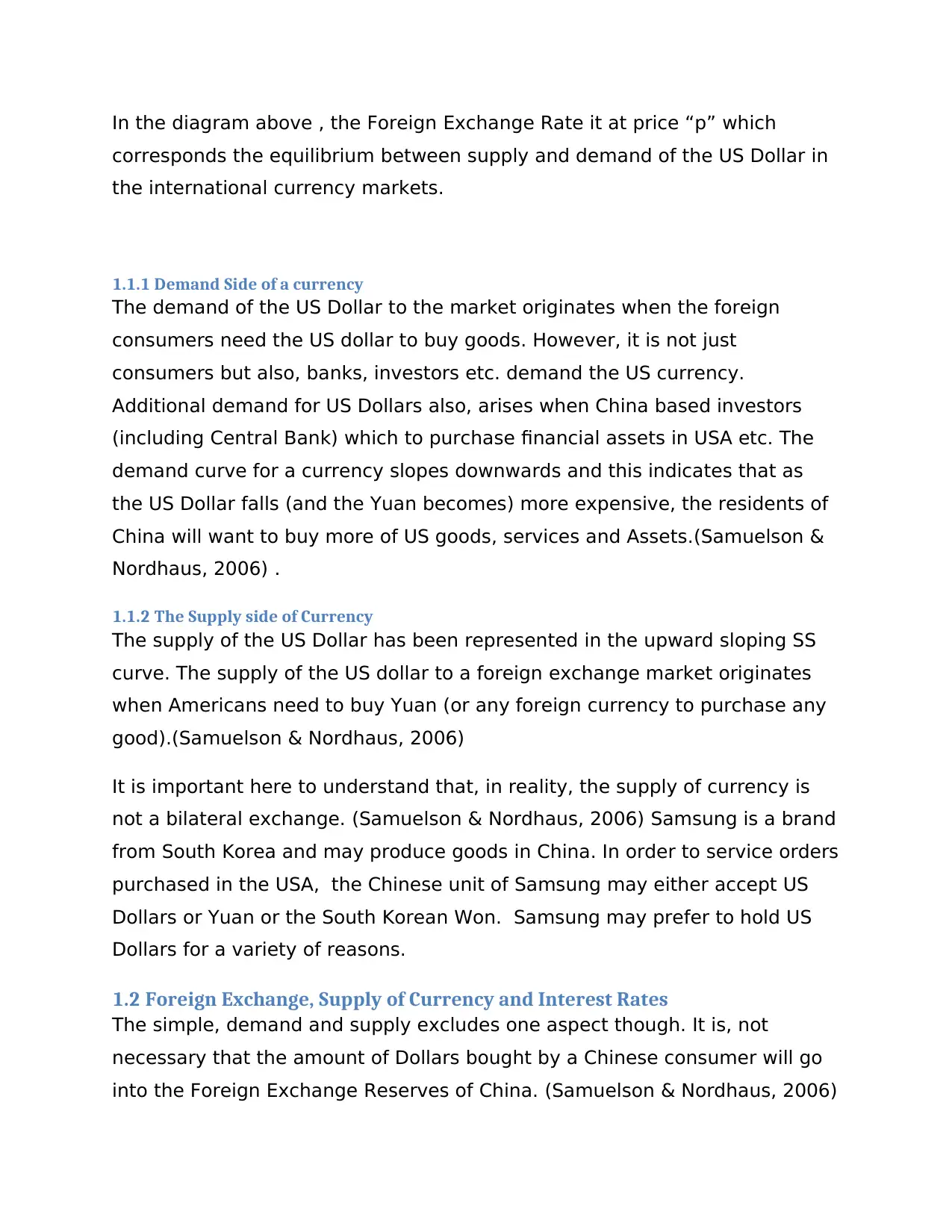
In the diagram above , the Foreign Exchange Rate it at price “p” which
corresponds the equilibrium between supply and demand of the US Dollar in
the international currency markets.
1.1.1 Demand Side of a currency
The demand of the US Dollar to the market originates when the foreign
consumers need the US dollar to buy goods. However, it is not just
consumers but also, banks, investors etc. demand the US currency.
Additional demand for US Dollars also, arises when China based investors
(including Central Bank) which to purchase financial assets in USA etc. The
demand curve for a currency slopes downwards and this indicates that as
the US Dollar falls (and the Yuan becomes) more expensive, the residents of
China will want to buy more of US goods, services and Assets.(Samuelson &
Nordhaus, 2006) .
1.1.2 The Supply side of Currency
The supply of the US Dollar has been represented in the upward sloping SS
curve. The supply of the US dollar to a foreign exchange market originates
when Americans need to buy Yuan (or any foreign currency to purchase any
good).(Samuelson & Nordhaus, 2006)
It is important here to understand that, in reality, the supply of currency is
not a bilateral exchange. (Samuelson & Nordhaus, 2006) Samsung is a brand
from South Korea and may produce goods in China. In order to service orders
purchased in the USA, the Chinese unit of Samsung may either accept US
Dollars or Yuan or the South Korean Won. Samsung may prefer to hold US
Dollars for a variety of reasons.
1.2 Foreign Exchange, Supply of Currency and Interest Rates
The simple, demand and supply excludes one aspect though. It is, not
necessary that the amount of Dollars bought by a Chinese consumer will go
into the Foreign Exchange Reserves of China. (Samuelson & Nordhaus, 2006)
corresponds the equilibrium between supply and demand of the US Dollar in
the international currency markets.
1.1.1 Demand Side of a currency
The demand of the US Dollar to the market originates when the foreign
consumers need the US dollar to buy goods. However, it is not just
consumers but also, banks, investors etc. demand the US currency.
Additional demand for US Dollars also, arises when China based investors
(including Central Bank) which to purchase financial assets in USA etc. The
demand curve for a currency slopes downwards and this indicates that as
the US Dollar falls (and the Yuan becomes) more expensive, the residents of
China will want to buy more of US goods, services and Assets.(Samuelson &
Nordhaus, 2006) .
1.1.2 The Supply side of Currency
The supply of the US Dollar has been represented in the upward sloping SS
curve. The supply of the US dollar to a foreign exchange market originates
when Americans need to buy Yuan (or any foreign currency to purchase any
good).(Samuelson & Nordhaus, 2006)
It is important here to understand that, in reality, the supply of currency is
not a bilateral exchange. (Samuelson & Nordhaus, 2006) Samsung is a brand
from South Korea and may produce goods in China. In order to service orders
purchased in the USA, the Chinese unit of Samsung may either accept US
Dollars or Yuan or the South Korean Won. Samsung may prefer to hold US
Dollars for a variety of reasons.
1.2 Foreign Exchange, Supply of Currency and Interest Rates
The simple, demand and supply excludes one aspect though. It is, not
necessary that the amount of Dollars bought by a Chinese consumer will go
into the Foreign Exchange Reserves of China. (Samuelson & Nordhaus, 2006)
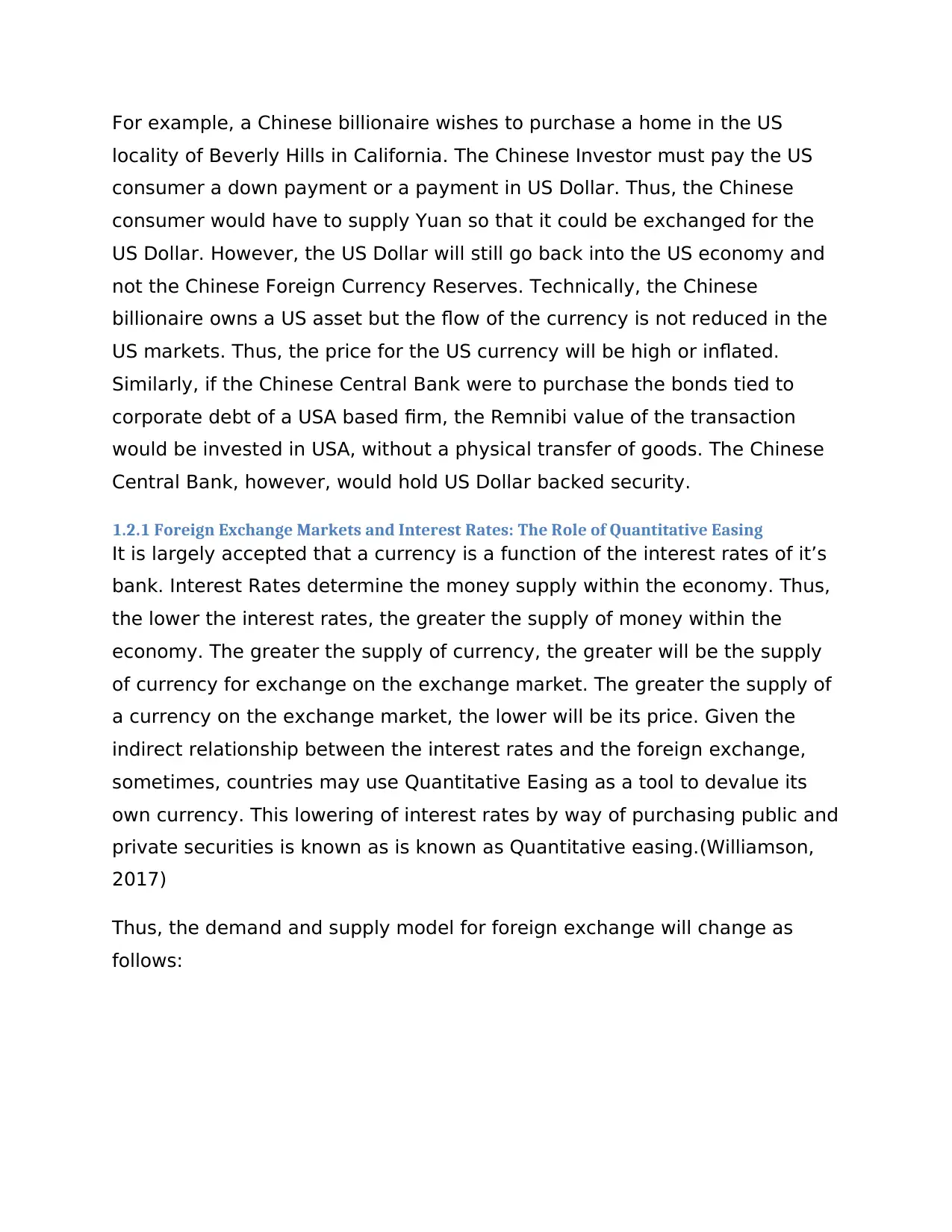
For example, a Chinese billionaire wishes to purchase a home in the US
locality of Beverly Hills in California. The Chinese Investor must pay the US
consumer a down payment or a payment in US Dollar. Thus, the Chinese
consumer would have to supply Yuan so that it could be exchanged for the
US Dollar. However, the US Dollar will still go back into the US economy and
not the Chinese Foreign Currency Reserves. Technically, the Chinese
billionaire owns a US asset but the flow of the currency is not reduced in the
US markets. Thus, the price for the US currency will be high or inflated.
Similarly, if the Chinese Central Bank were to purchase the bonds tied to
corporate debt of a USA based firm, the Remnibi value of the transaction
would be invested in USA, without a physical transfer of goods. The Chinese
Central Bank, however, would hold US Dollar backed security.
1.2.1 Foreign Exchange Markets and Interest Rates: The Role of Quantitative Easing
It is largely accepted that a currency is a function of the interest rates of it’s
bank. Interest Rates determine the money supply within the economy. Thus,
the lower the interest rates, the greater the supply of money within the
economy. The greater the supply of currency, the greater will be the supply
of currency for exchange on the exchange market. The greater the supply of
a currency on the exchange market, the lower will be its price. Given the
indirect relationship between the interest rates and the foreign exchange,
sometimes, countries may use Quantitative Easing as a tool to devalue its
own currency. This lowering of interest rates by way of purchasing public and
private securities is known as is known as Quantitative easing.(Williamson,
2017)
Thus, the demand and supply model for foreign exchange will change as
follows:
locality of Beverly Hills in California. The Chinese Investor must pay the US
consumer a down payment or a payment in US Dollar. Thus, the Chinese
consumer would have to supply Yuan so that it could be exchanged for the
US Dollar. However, the US Dollar will still go back into the US economy and
not the Chinese Foreign Currency Reserves. Technically, the Chinese
billionaire owns a US asset but the flow of the currency is not reduced in the
US markets. Thus, the price for the US currency will be high or inflated.
Similarly, if the Chinese Central Bank were to purchase the bonds tied to
corporate debt of a USA based firm, the Remnibi value of the transaction
would be invested in USA, without a physical transfer of goods. The Chinese
Central Bank, however, would hold US Dollar backed security.
1.2.1 Foreign Exchange Markets and Interest Rates: The Role of Quantitative Easing
It is largely accepted that a currency is a function of the interest rates of it’s
bank. Interest Rates determine the money supply within the economy. Thus,
the lower the interest rates, the greater the supply of money within the
economy. The greater the supply of currency, the greater will be the supply
of currency for exchange on the exchange market. The greater the supply of
a currency on the exchange market, the lower will be its price. Given the
indirect relationship between the interest rates and the foreign exchange,
sometimes, countries may use Quantitative Easing as a tool to devalue its
own currency. This lowering of interest rates by way of purchasing public and
private securities is known as is known as Quantitative easing.(Williamson,
2017)
Thus, the demand and supply model for foreign exchange will change as
follows:
Paraphrase This Document
Need a fresh take? Get an instant paraphrase of this document with our AI Paraphraser
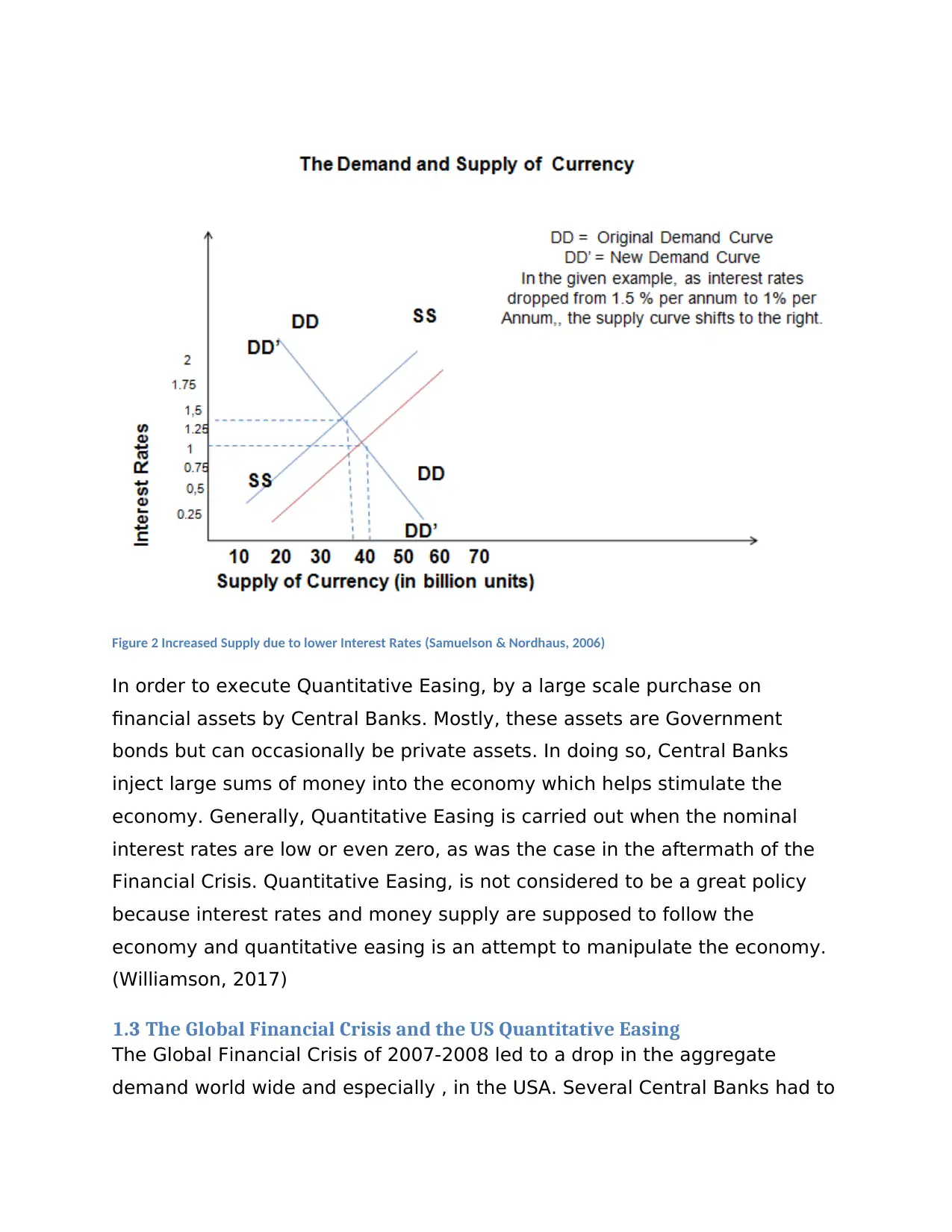
Figure 2 Increased Supply due to lower Interest Rates (Samuelson & Nordhaus, 2006)
In order to execute Quantitative Easing, by a large scale purchase on
financial assets by Central Banks. Mostly, these assets are Government
bonds but can occasionally be private assets. In doing so, Central Banks
inject large sums of money into the economy which helps stimulate the
economy. Generally, Quantitative Easing is carried out when the nominal
interest rates are low or even zero, as was the case in the aftermath of the
Financial Crisis. Quantitative Easing, is not considered to be a great policy
because interest rates and money supply are supposed to follow the
economy and quantitative easing is an attempt to manipulate the economy.
(Williamson, 2017)
1.3 The Global Financial Crisis and the US Quantitative Easing
The Global Financial Crisis of 2007-2008 led to a drop in the aggregate
demand world wide and especially , in the USA. Several Central Banks had to
In order to execute Quantitative Easing, by a large scale purchase on
financial assets by Central Banks. Mostly, these assets are Government
bonds but can occasionally be private assets. In doing so, Central Banks
inject large sums of money into the economy which helps stimulate the
economy. Generally, Quantitative Easing is carried out when the nominal
interest rates are low or even zero, as was the case in the aftermath of the
Financial Crisis. Quantitative Easing, is not considered to be a great policy
because interest rates and money supply are supposed to follow the
economy and quantitative easing is an attempt to manipulate the economy.
(Williamson, 2017)
1.3 The Global Financial Crisis and the US Quantitative Easing
The Global Financial Crisis of 2007-2008 led to a drop in the aggregate
demand world wide and especially , in the USA. Several Central Banks had to

keep interest rates near Zero. This led to the narrowing margins between the
Long Term and Short Term Interest Rates. (Williamson, 2017)
There are several reasons that lead Central Bankers to adopt Quantitative
easing but one of the reasons is that the process of Quantitative Easing
converts Long Term Bonds in Short Term Reserves while flushing out the
short term reserves into the economy. (Williamson, 2017) This presents risks
within the banking system. With cash reserves gone, there is a serious risks
that banks would be able to lend money for mortgage backed securities. In
the absence of enough credit, business’s going concern would be affected.
The ability to pay loans back would be affected by such a move.(Knowledge
At Wharton, 2011) Moreover, banks themselves were at risk, as the cash
reserves would dry up. The bank’s ability to pay its depositors would be
affected. Additionally, when cash reserves run low, consumer confidence
may run low and depositor’s may make a run towards banks.
1.4 Quantitative Easing by Federal Reserve Bank of USA: The Impact on China
1.4.1 Background: The Chinese Practice of Devalued Currency
China had a practice of interventions in the rate of its currency by keeping it
devalued, in order to ensure that the it’s exports remained low priced. China
usually, pursued this policy by buying large sums of foreign currency. Around
2009, China had held a substantial amount of US securities . The US Dollar
was overweight in the portfolio of the Central Bank of China. (Evans-
Pritchard, 2009)
1.4.2 Quantitative Easing between 2008 and 2013
In November 2008, The US announced the launch of, what came to be known
as Quantitative Easing 1. By September 2012, the US Federal Reserve Bank
launched a third round of easing , which was its largest round. During this
Long Term and Short Term Interest Rates. (Williamson, 2017)
There are several reasons that lead Central Bankers to adopt Quantitative
easing but one of the reasons is that the process of Quantitative Easing
converts Long Term Bonds in Short Term Reserves while flushing out the
short term reserves into the economy. (Williamson, 2017) This presents risks
within the banking system. With cash reserves gone, there is a serious risks
that banks would be able to lend money for mortgage backed securities. In
the absence of enough credit, business’s going concern would be affected.
The ability to pay loans back would be affected by such a move.(Knowledge
At Wharton, 2011) Moreover, banks themselves were at risk, as the cash
reserves would dry up. The bank’s ability to pay its depositors would be
affected. Additionally, when cash reserves run low, consumer confidence
may run low and depositor’s may make a run towards banks.
1.4 Quantitative Easing by Federal Reserve Bank of USA: The Impact on China
1.4.1 Background: The Chinese Practice of Devalued Currency
China had a practice of interventions in the rate of its currency by keeping it
devalued, in order to ensure that the it’s exports remained low priced. China
usually, pursued this policy by buying large sums of foreign currency. Around
2009, China had held a substantial amount of US securities . The US Dollar
was overweight in the portfolio of the Central Bank of China. (Evans-
Pritchard, 2009)
1.4.2 Quantitative Easing between 2008 and 2013
In November 2008, The US announced the launch of, what came to be known
as Quantitative Easing 1. By September 2012, the US Federal Reserve Bank
launched a third round of easing , which was its largest round. During this
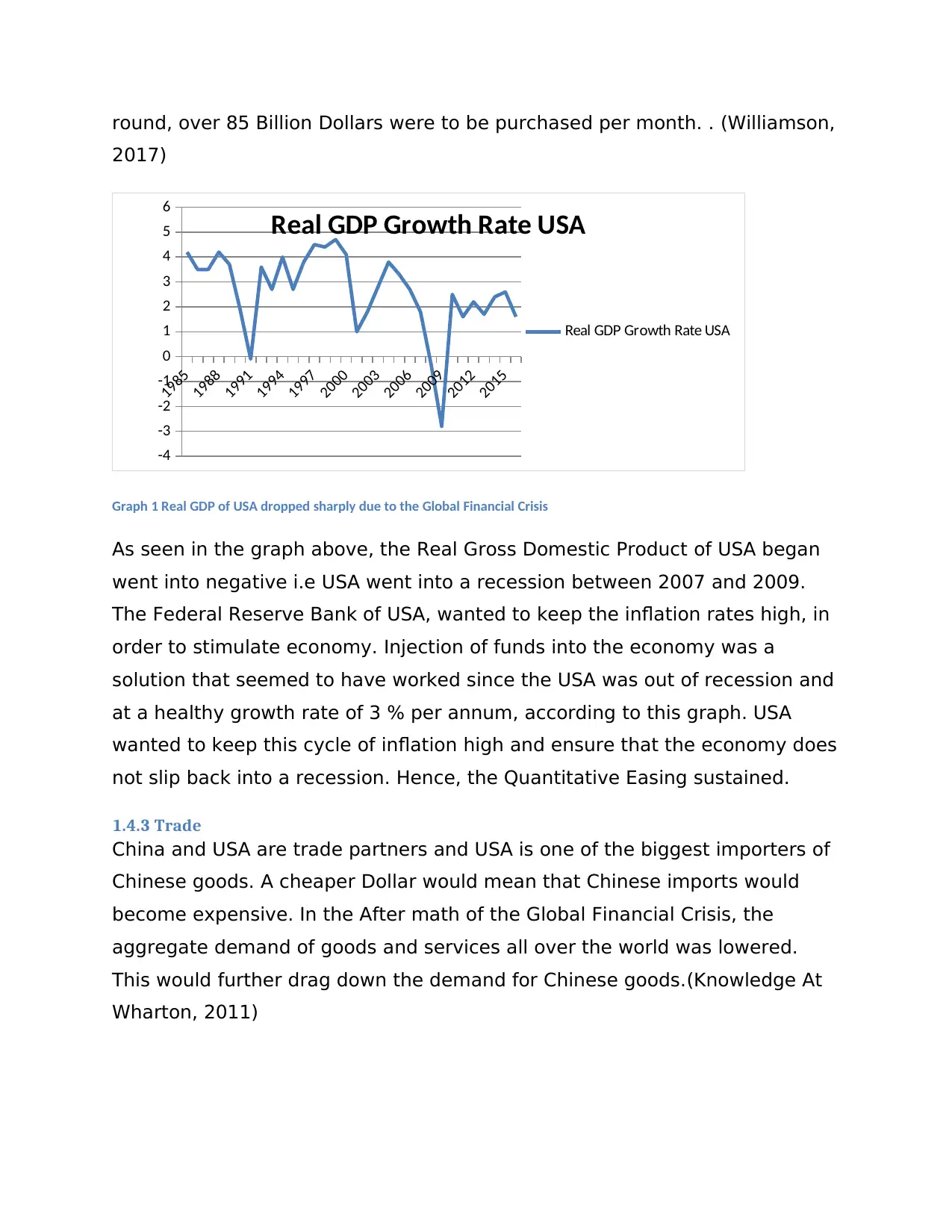
round, over 85 Billion Dollars were to be purchased per month. . (Williamson,
2017)
1985
1988
1991
1994
1997
2000
2003
2006
2009
2012
2015
-4
-3
-2
-1
0
1
2
3
4
5
6
Real GDP Growth Rate USA
Real GDP Growth Rate USA
Graph 1 Real GDP of USA dropped sharply due to the Global Financial Crisis
As seen in the graph above, the Real Gross Domestic Product of USA began
went into negative i.e USA went into a recession between 2007 and 2009.
The Federal Reserve Bank of USA, wanted to keep the inflation rates high, in
order to stimulate economy. Injection of funds into the economy was a
solution that seemed to have worked since the USA was out of recession and
at a healthy growth rate of 3 % per annum, according to this graph. USA
wanted to keep this cycle of inflation high and ensure that the economy does
not slip back into a recession. Hence, the Quantitative Easing sustained.
1.4.3 Trade
China and USA are trade partners and USA is one of the biggest importers of
Chinese goods. A cheaper Dollar would mean that Chinese imports would
become expensive. In the After math of the Global Financial Crisis, the
aggregate demand of goods and services all over the world was lowered.
This would further drag down the demand for Chinese goods.(Knowledge At
Wharton, 2011)
2017)
1985
1988
1991
1994
1997
2000
2003
2006
2009
2012
2015
-4
-3
-2
-1
0
1
2
3
4
5
6
Real GDP Growth Rate USA
Real GDP Growth Rate USA
Graph 1 Real GDP of USA dropped sharply due to the Global Financial Crisis
As seen in the graph above, the Real Gross Domestic Product of USA began
went into negative i.e USA went into a recession between 2007 and 2009.
The Federal Reserve Bank of USA, wanted to keep the inflation rates high, in
order to stimulate economy. Injection of funds into the economy was a
solution that seemed to have worked since the USA was out of recession and
at a healthy growth rate of 3 % per annum, according to this graph. USA
wanted to keep this cycle of inflation high and ensure that the economy does
not slip back into a recession. Hence, the Quantitative Easing sustained.
1.4.3 Trade
China and USA are trade partners and USA is one of the biggest importers of
Chinese goods. A cheaper Dollar would mean that Chinese imports would
become expensive. In the After math of the Global Financial Crisis, the
aggregate demand of goods and services all over the world was lowered.
This would further drag down the demand for Chinese goods.(Knowledge At
Wharton, 2011)
Secure Best Marks with AI Grader
Need help grading? Try our AI Grader for instant feedback on your assignments.
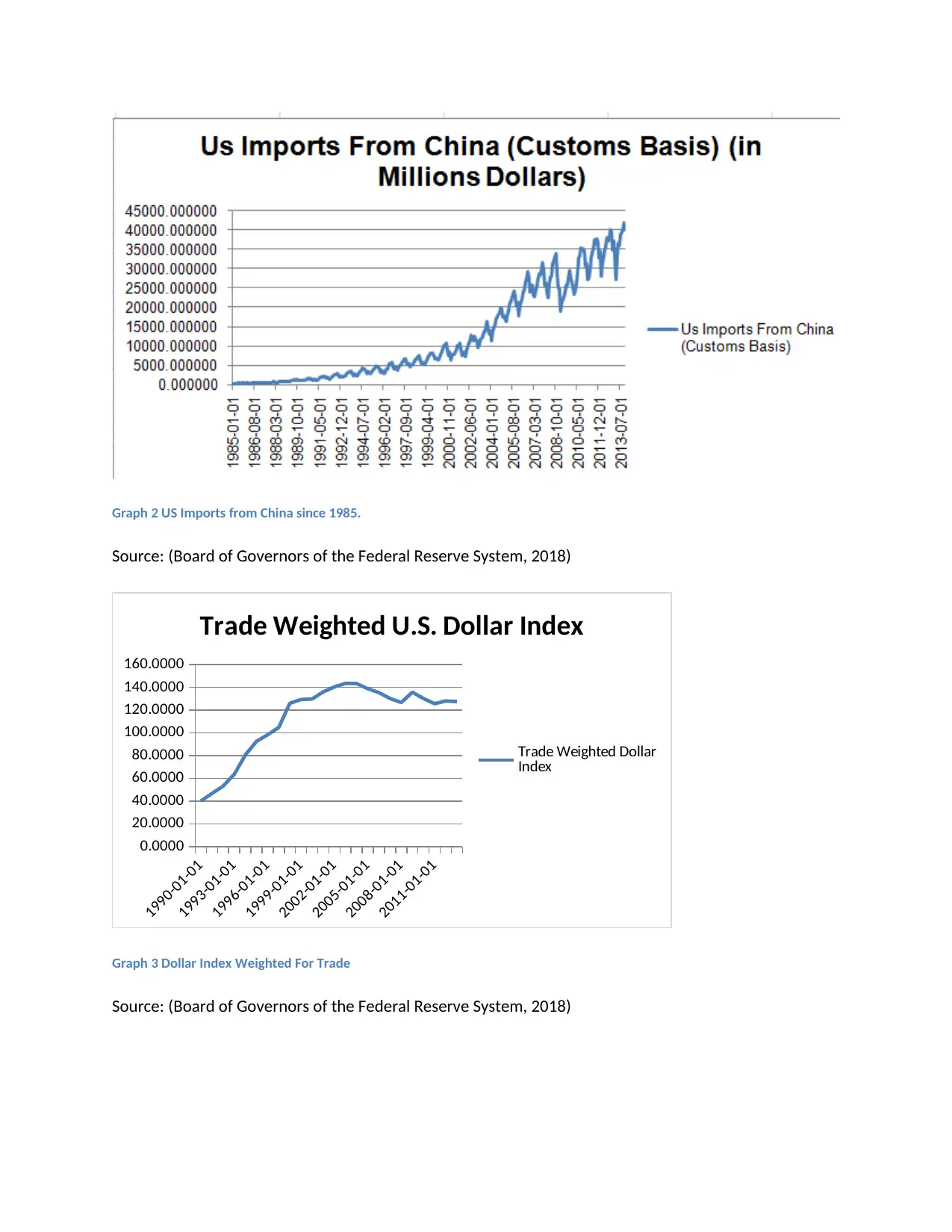
Graph 2 US Imports from China since 1985.
Source: (Board of Governors of the Federal Reserve System, 2018)
1990-01-01
1993-01-01
1996-01-01
1999-01-01
2002-01-01
2005-01-01
2008-01-01
2011-01-01
0.0000
20.0000
40.0000
60.0000
80.0000
100.0000
120.0000
140.0000
160.0000
Trade Weighted U.S. Dollar Index
Trade Weighted Dollar
Index
Graph 3 Dollar Index Weighted For Trade
Source: (Board of Governors of the Federal Reserve System, 2018)
Source: (Board of Governors of the Federal Reserve System, 2018)
1990-01-01
1993-01-01
1996-01-01
1999-01-01
2002-01-01
2005-01-01
2008-01-01
2011-01-01
0.0000
20.0000
40.0000
60.0000
80.0000
100.0000
120.0000
140.0000
160.0000
Trade Weighted U.S. Dollar Index
Trade Weighted Dollar
Index
Graph 3 Dollar Index Weighted For Trade
Source: (Board of Governors of the Federal Reserve System, 2018)
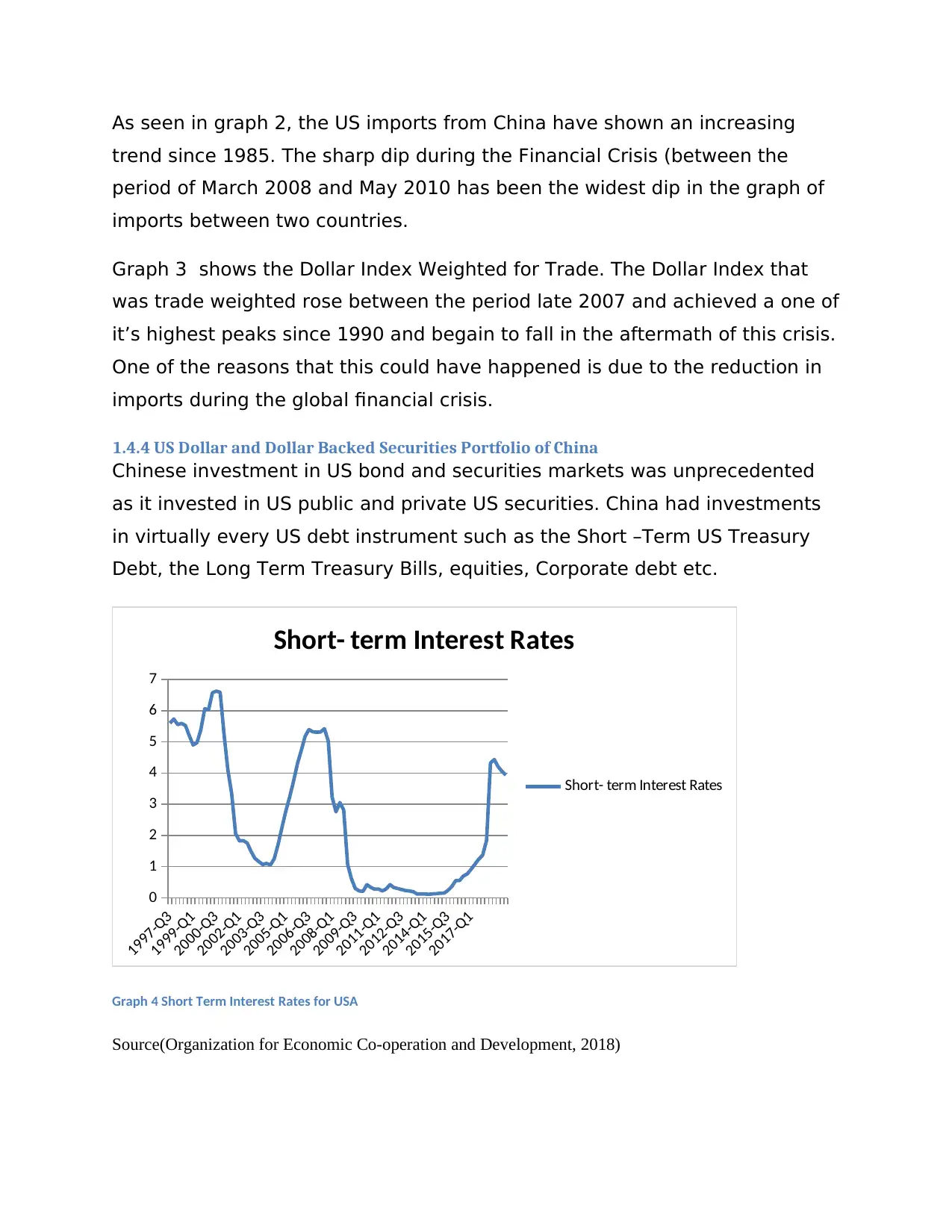
As seen in graph 2, the US imports from China have shown an increasing
trend since 1985. The sharp dip during the Financial Crisis (between the
period of March 2008 and May 2010 has been the widest dip in the graph of
imports between two countries.
Graph 3 shows the Dollar Index Weighted for Trade. The Dollar Index that
was trade weighted rose between the period late 2007 and achieved a one of
it’s highest peaks since 1990 and begain to fall in the aftermath of this crisis.
One of the reasons that this could have happened is due to the reduction in
imports during the global financial crisis.
1.4.4 US Dollar and Dollar Backed Securities Portfolio of China
Chinese investment in US bond and securities markets was unprecedented
as it invested in US public and private US securities. China had investments
in virtually every US debt instrument such as the Short –Term US Treasury
Debt, the Long Term Treasury Bills, equities, Corporate debt etc.
1997-Q3
1999-Q1
2000-Q3
2002-Q1
2003-Q3
2005-Q1
2006-Q3
2008-Q1
2009-Q3
2011-Q1
2012-Q3
2014-Q1
2015-Q3
2017-Q1
0
1
2
3
4
5
6
7
Short- term Interest Rates
Short- term Interest Rates
Graph 4 Short Term Interest Rates for USA
Source(Organization for Economic Co-operation and Development, 2018)
trend since 1985. The sharp dip during the Financial Crisis (between the
period of March 2008 and May 2010 has been the widest dip in the graph of
imports between two countries.
Graph 3 shows the Dollar Index Weighted for Trade. The Dollar Index that
was trade weighted rose between the period late 2007 and achieved a one of
it’s highest peaks since 1990 and begain to fall in the aftermath of this crisis.
One of the reasons that this could have happened is due to the reduction in
imports during the global financial crisis.
1.4.4 US Dollar and Dollar Backed Securities Portfolio of China
Chinese investment in US bond and securities markets was unprecedented
as it invested in US public and private US securities. China had investments
in virtually every US debt instrument such as the Short –Term US Treasury
Debt, the Long Term Treasury Bills, equities, Corporate debt etc.
1997-Q3
1999-Q1
2000-Q3
2002-Q1
2003-Q3
2005-Q1
2006-Q3
2008-Q1
2009-Q3
2011-Q1
2012-Q3
2014-Q1
2015-Q3
2017-Q1
0
1
2
3
4
5
6
7
Short- term Interest Rates
Short- term Interest Rates
Graph 4 Short Term Interest Rates for USA
Source(Organization for Economic Co-operation and Development, 2018)
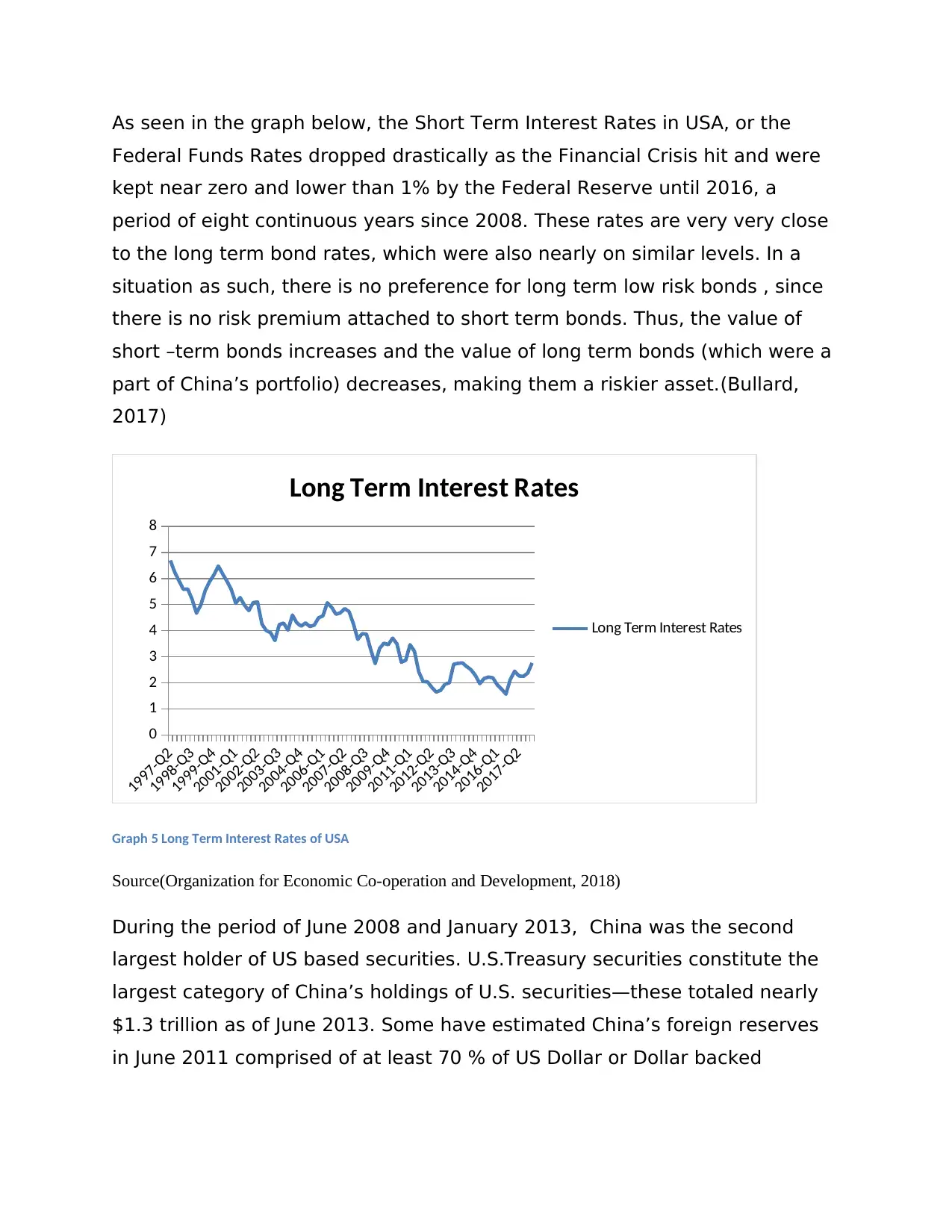
As seen in the graph below, the Short Term Interest Rates in USA, or the
Federal Funds Rates dropped drastically as the Financial Crisis hit and were
kept near zero and lower than 1% by the Federal Reserve until 2016, a
period of eight continuous years since 2008. These rates are very very close
to the long term bond rates, which were also nearly on similar levels. In a
situation as such, there is no preference for long term low risk bonds , since
there is no risk premium attached to short term bonds. Thus, the value of
short –term bonds increases and the value of long term bonds (which were a
part of China’s portfolio) decreases, making them a riskier asset.(Bullard,
2017)
1997-Q2
1998-Q3
1999-Q4
2001-Q1
2002-Q2
2003-Q3
2004-Q4
2006-Q1
2007-Q2
2008-Q3
2009-Q4
2011-Q1
2012-Q2
2013-Q3
2014-Q4
2016-Q1
2017-Q2
0
1
2
3
4
5
6
7
8
Long Term Interest Rates
Long Term Interest Rates
Graph 5 Long Term Interest Rates of USA
Source(Organization for Economic Co-operation and Development, 2018)
During the period of June 2008 and January 2013, China was the second
largest holder of US based securities. U.S.Treasury securities constitute the
largest category of China’s holdings of U.S. securities—these totaled nearly
$1.3 trillion as of June 2013. Some have estimated China’s foreign reserves
in June 2011 comprised of at least 70 % of US Dollar or Dollar backed
Federal Funds Rates dropped drastically as the Financial Crisis hit and were
kept near zero and lower than 1% by the Federal Reserve until 2016, a
period of eight continuous years since 2008. These rates are very very close
to the long term bond rates, which were also nearly on similar levels. In a
situation as such, there is no preference for long term low risk bonds , since
there is no risk premium attached to short term bonds. Thus, the value of
short –term bonds increases and the value of long term bonds (which were a
part of China’s portfolio) decreases, making them a riskier asset.(Bullard,
2017)
1997-Q2
1998-Q3
1999-Q4
2001-Q1
2002-Q2
2003-Q3
2004-Q4
2006-Q1
2007-Q2
2008-Q3
2009-Q4
2011-Q1
2012-Q2
2013-Q3
2014-Q4
2016-Q1
2017-Q2
0
1
2
3
4
5
6
7
8
Long Term Interest Rates
Long Term Interest Rates
Graph 5 Long Term Interest Rates of USA
Source(Organization for Economic Co-operation and Development, 2018)
During the period of June 2008 and January 2013, China was the second
largest holder of US based securities. U.S.Treasury securities constitute the
largest category of China’s holdings of U.S. securities—these totaled nearly
$1.3 trillion as of June 2013. Some have estimated China’s foreign reserves
in June 2011 comprised of at least 70 % of US Dollar or Dollar backed
Paraphrase This Document
Need a fresh take? Get an instant paraphrase of this document with our AI Paraphraser
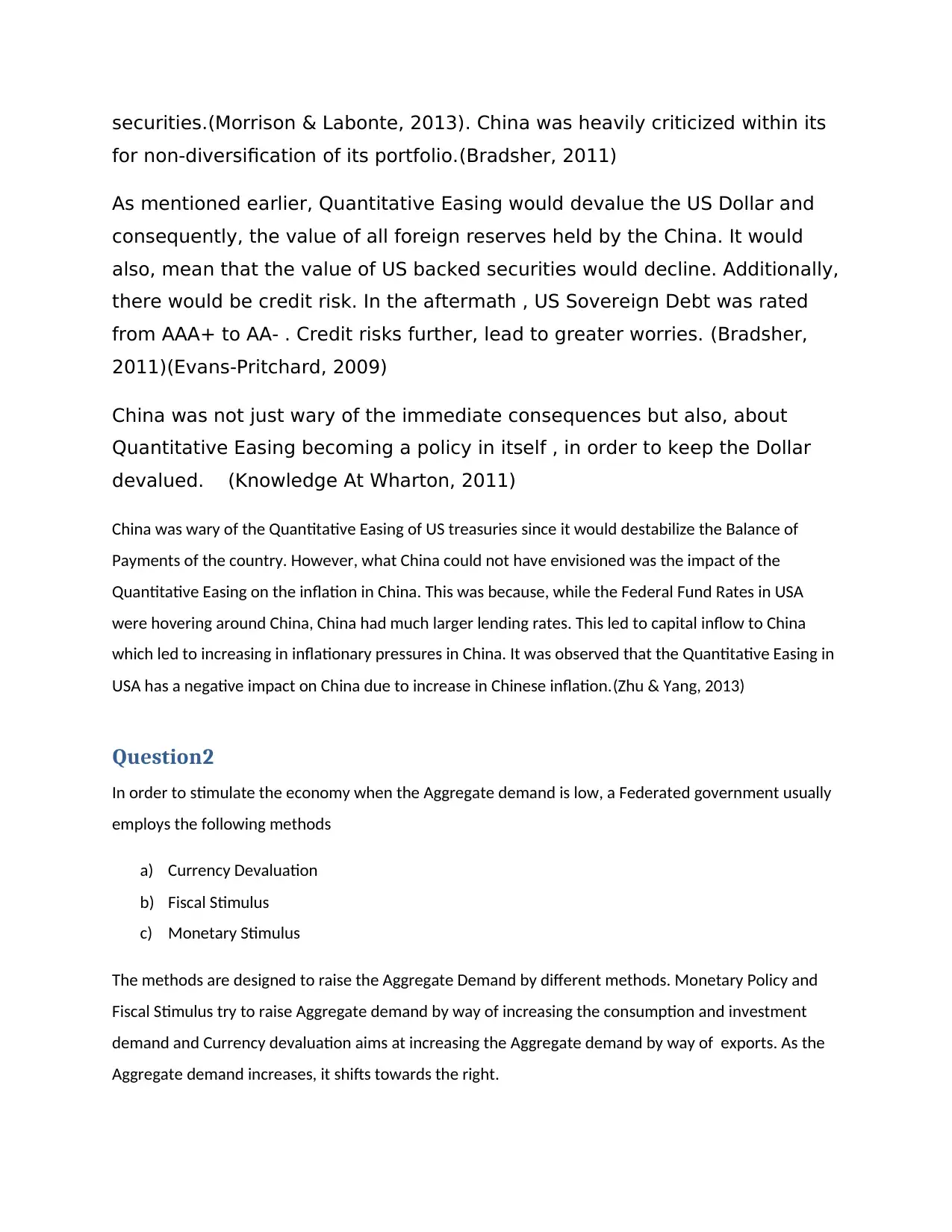
securities.(Morrison & Labonte, 2013). China was heavily criticized within its
for non-diversification of its portfolio.(Bradsher, 2011)
As mentioned earlier, Quantitative Easing would devalue the US Dollar and
consequently, the value of all foreign reserves held by the China. It would
also, mean that the value of US backed securities would decline. Additionally,
there would be credit risk. In the aftermath , US Sovereign Debt was rated
from AAA+ to AA- . Credit risks further, lead to greater worries. (Bradsher,
2011)(Evans-Pritchard, 2009)
China was not just wary of the immediate consequences but also, about
Quantitative Easing becoming a policy in itself , in order to keep the Dollar
devalued. (Knowledge At Wharton, 2011)
China was wary of the Quantitative Easing of US treasuries since it would destabilize the Balance of
Payments of the country. However, what China could not have envisioned was the impact of the
Quantitative Easing on the inflation in China. This was because, while the Federal Fund Rates in USA
were hovering around China, China had much larger lending rates. This led to capital inflow to China
which led to increasing in inflationary pressures in China. It was observed that the Quantitative Easing in
USA has a negative impact on China due to increase in Chinese inflation.(Zhu & Yang, 2013)
Question2
In order to stimulate the economy when the Aggregate demand is low, a Federated government usually
employs the following methods
a) Currency Devaluation
b) Fiscal Stimulus
c) Monetary Stimulus
The methods are designed to raise the Aggregate Demand by different methods. Monetary Policy and
Fiscal Stimulus try to raise Aggregate demand by way of increasing the consumption and investment
demand and Currency devaluation aims at increasing the Aggregate demand by way of exports. As the
Aggregate demand increases, it shifts towards the right.
for non-diversification of its portfolio.(Bradsher, 2011)
As mentioned earlier, Quantitative Easing would devalue the US Dollar and
consequently, the value of all foreign reserves held by the China. It would
also, mean that the value of US backed securities would decline. Additionally,
there would be credit risk. In the aftermath , US Sovereign Debt was rated
from AAA+ to AA- . Credit risks further, lead to greater worries. (Bradsher,
2011)(Evans-Pritchard, 2009)
China was not just wary of the immediate consequences but also, about
Quantitative Easing becoming a policy in itself , in order to keep the Dollar
devalued. (Knowledge At Wharton, 2011)
China was wary of the Quantitative Easing of US treasuries since it would destabilize the Balance of
Payments of the country. However, what China could not have envisioned was the impact of the
Quantitative Easing on the inflation in China. This was because, while the Federal Fund Rates in USA
were hovering around China, China had much larger lending rates. This led to capital inflow to China
which led to increasing in inflationary pressures in China. It was observed that the Quantitative Easing in
USA has a negative impact on China due to increase in Chinese inflation.(Zhu & Yang, 2013)
Question2
In order to stimulate the economy when the Aggregate demand is low, a Federated government usually
employs the following methods
a) Currency Devaluation
b) Fiscal Stimulus
c) Monetary Stimulus
The methods are designed to raise the Aggregate Demand by different methods. Monetary Policy and
Fiscal Stimulus try to raise Aggregate demand by way of increasing the consumption and investment
demand and Currency devaluation aims at increasing the Aggregate demand by way of exports. As the
Aggregate demand increases, it shifts towards the right.
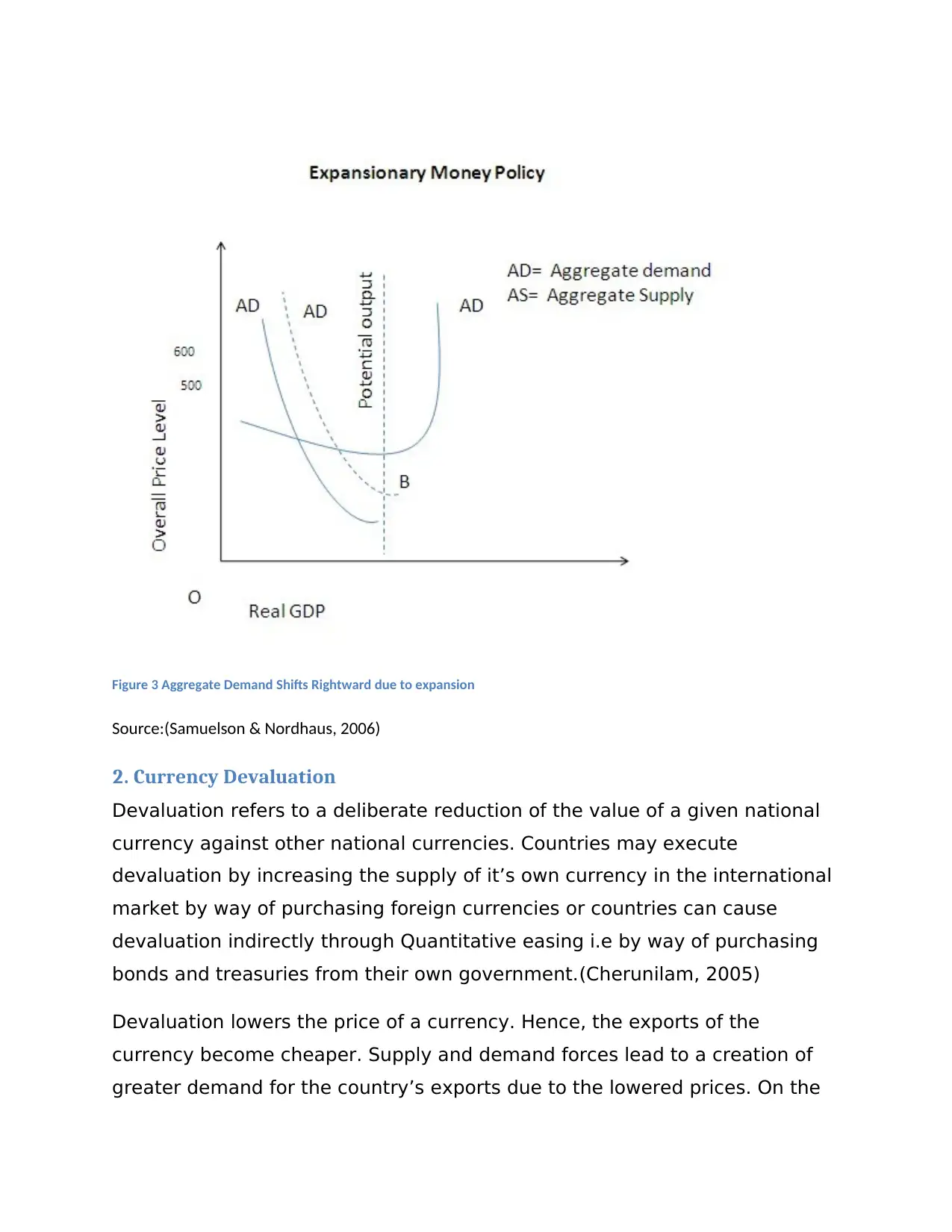
Figure 3 Aggregate Demand Shifts Rightward due to expansion
Source:(Samuelson & Nordhaus, 2006)
2. Currency Devaluation
Devaluation refers to a deliberate reduction of the value of a given national
currency against other national currencies. Countries may execute
devaluation by increasing the supply of it’s own currency in the international
market by way of purchasing foreign currencies or countries can cause
devaluation indirectly through Quantitative easing i.e by way of purchasing
bonds and treasuries from their own government.(Cherunilam, 2005)
Devaluation lowers the price of a currency. Hence, the exports of the
currency become cheaper. Supply and demand forces lead to a creation of
greater demand for the country’s exports due to the lowered prices. On the
Source:(Samuelson & Nordhaus, 2006)
2. Currency Devaluation
Devaluation refers to a deliberate reduction of the value of a given national
currency against other national currencies. Countries may execute
devaluation by increasing the supply of it’s own currency in the international
market by way of purchasing foreign currencies or countries can cause
devaluation indirectly through Quantitative easing i.e by way of purchasing
bonds and treasuries from their own government.(Cherunilam, 2005)
Devaluation lowers the price of a currency. Hence, the exports of the
currency become cheaper. Supply and demand forces lead to a creation of
greater demand for the country’s exports due to the lowered prices. On the
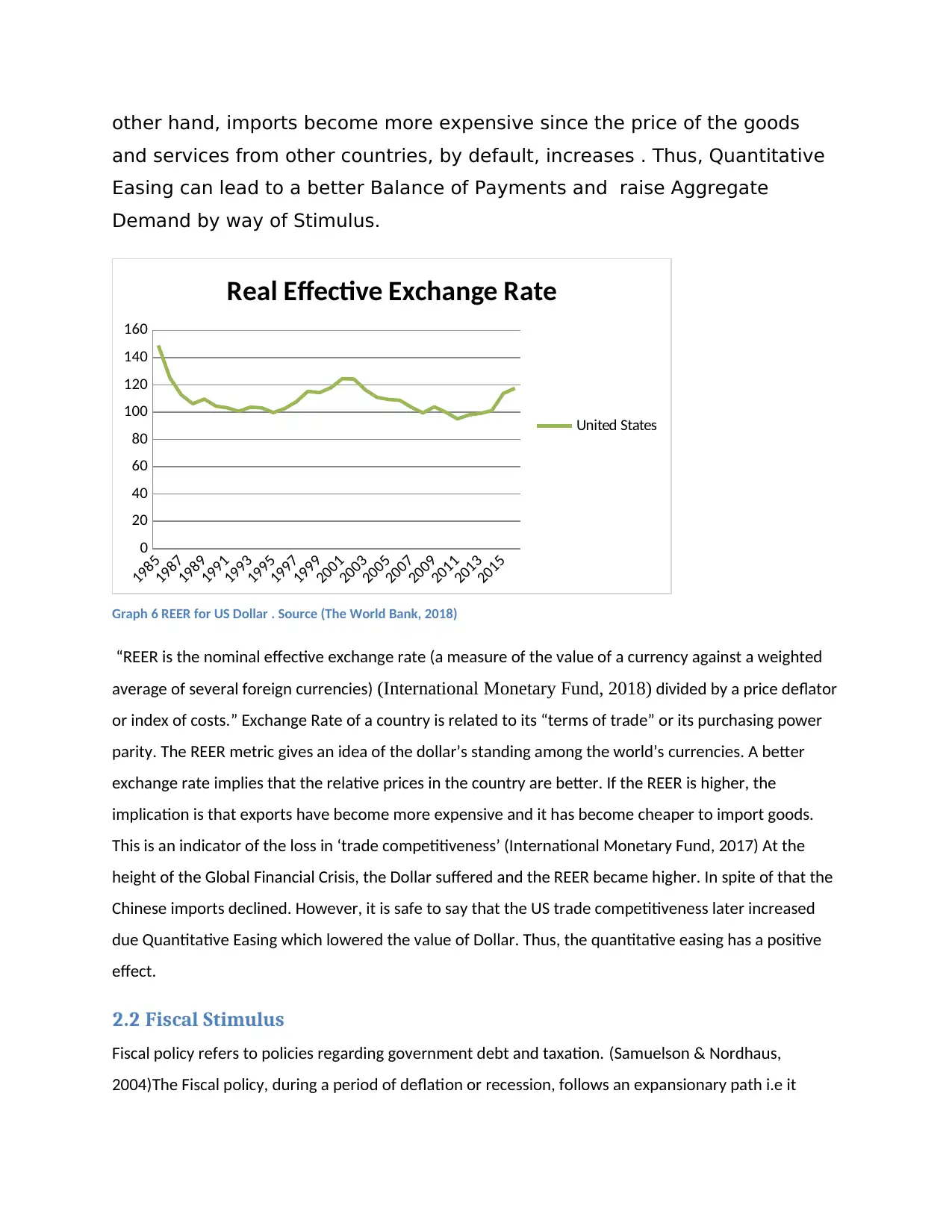
other hand, imports become more expensive since the price of the goods
and services from other countries, by default, increases . Thus, Quantitative
Easing can lead to a better Balance of Payments and raise Aggregate
Demand by way of Stimulus.
1985
1987
1989
1991
1993
1995
1997
1999
2001
2003
2005
2007
2009
2011
2013
2015
0
20
40
60
80
100
120
140
160
Real Effective Exchange Rate
United States
Graph 6 REER for US Dollar . Source (The World Bank, 2018)
“REER is the nominal effective exchange rate (a measure of the value of a currency against a weighted
average of several foreign currencies) (International Monetary Fund, 2018) divided by a price deflator
or index of costs.” Exchange Rate of a country is related to its “terms of trade” or its purchasing power
parity. The REER metric gives an idea of the dollar’s standing among the world’s currencies. A better
exchange rate implies that the relative prices in the country are better. If the REER is higher, the
implication is that exports have become more expensive and it has become cheaper to import goods.
This is an indicator of the loss in ‘trade competitiveness’ (International Monetary Fund, 2017) At the
height of the Global Financial Crisis, the Dollar suffered and the REER became higher. In spite of that the
Chinese imports declined. However, it is safe to say that the US trade competitiveness later increased
due Quantitative Easing which lowered the value of Dollar. Thus, the quantitative easing has a positive
effect.
2.2 Fiscal Stimulus
Fiscal policy refers to policies regarding government debt and taxation. (Samuelson & Nordhaus,
2004)The Fiscal policy, during a period of deflation or recession, follows an expansionary path i.e it
and services from other countries, by default, increases . Thus, Quantitative
Easing can lead to a better Balance of Payments and raise Aggregate
Demand by way of Stimulus.
1985
1987
1989
1991
1993
1995
1997
1999
2001
2003
2005
2007
2009
2011
2013
2015
0
20
40
60
80
100
120
140
160
Real Effective Exchange Rate
United States
Graph 6 REER for US Dollar . Source (The World Bank, 2018)
“REER is the nominal effective exchange rate (a measure of the value of a currency against a weighted
average of several foreign currencies) (International Monetary Fund, 2018) divided by a price deflator
or index of costs.” Exchange Rate of a country is related to its “terms of trade” or its purchasing power
parity. The REER metric gives an idea of the dollar’s standing among the world’s currencies. A better
exchange rate implies that the relative prices in the country are better. If the REER is higher, the
implication is that exports have become more expensive and it has become cheaper to import goods.
This is an indicator of the loss in ‘trade competitiveness’ (International Monetary Fund, 2017) At the
height of the Global Financial Crisis, the Dollar suffered and the REER became higher. In spite of that the
Chinese imports declined. However, it is safe to say that the US trade competitiveness later increased
due Quantitative Easing which lowered the value of Dollar. Thus, the quantitative easing has a positive
effect.
2.2 Fiscal Stimulus
Fiscal policy refers to policies regarding government debt and taxation. (Samuelson & Nordhaus,
2004)The Fiscal policy, during a period of deflation or recession, follows an expansionary path i.e it
Secure Best Marks with AI Grader
Need help grading? Try our AI Grader for instant feedback on your assignments.
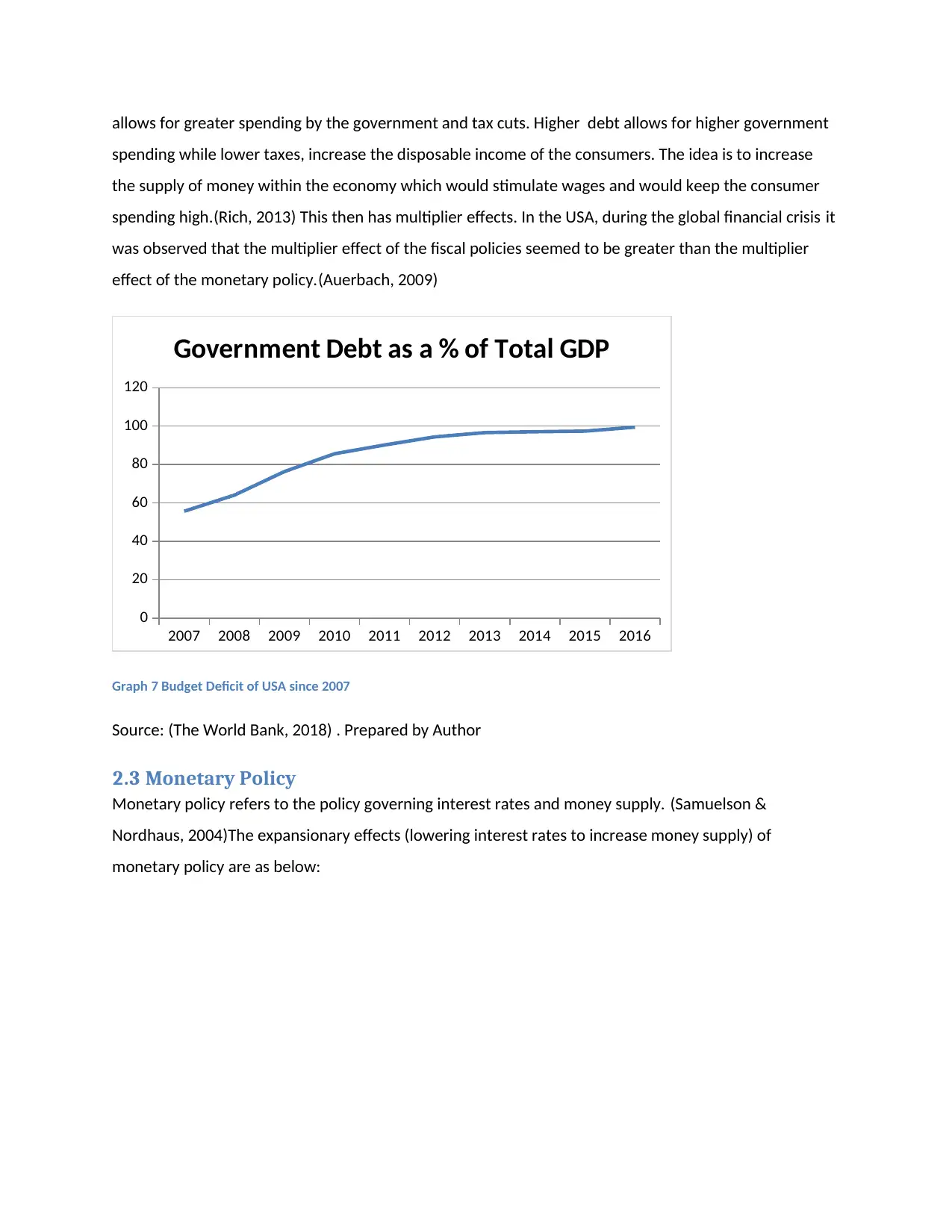
allows for greater spending by the government and tax cuts. Higher debt allows for higher government
spending while lower taxes, increase the disposable income of the consumers. The idea is to increase
the supply of money within the economy which would stimulate wages and would keep the consumer
spending high.(Rich, 2013) This then has multiplier effects. In the USA, during the global financial crisis it
was observed that the multiplier effect of the fiscal policies seemed to be greater than the multiplier
effect of the monetary policy.(Auerbach, 2009)
2007 2008 2009 2010 2011 2012 2013 2014 2015 2016
0
20
40
60
80
100
120
Government Debt as a % of Total GDP
Graph 7 Budget Deficit of USA since 2007
Source: (The World Bank, 2018) . Prepared by Author
2.3 Monetary Policy
Monetary policy refers to the policy governing interest rates and money supply. (Samuelson &
Nordhaus, 2004)The expansionary effects (lowering interest rates to increase money supply) of
monetary policy are as below:
spending while lower taxes, increase the disposable income of the consumers. The idea is to increase
the supply of money within the economy which would stimulate wages and would keep the consumer
spending high.(Rich, 2013) This then has multiplier effects. In the USA, during the global financial crisis it
was observed that the multiplier effect of the fiscal policies seemed to be greater than the multiplier
effect of the monetary policy.(Auerbach, 2009)
2007 2008 2009 2010 2011 2012 2013 2014 2015 2016
0
20
40
60
80
100
120
Government Debt as a % of Total GDP
Graph 7 Budget Deficit of USA since 2007
Source: (The World Bank, 2018) . Prepared by Author
2.3 Monetary Policy
Monetary policy refers to the policy governing interest rates and money supply. (Samuelson &
Nordhaus, 2004)The expansionary effects (lowering interest rates to increase money supply) of
monetary policy are as below:
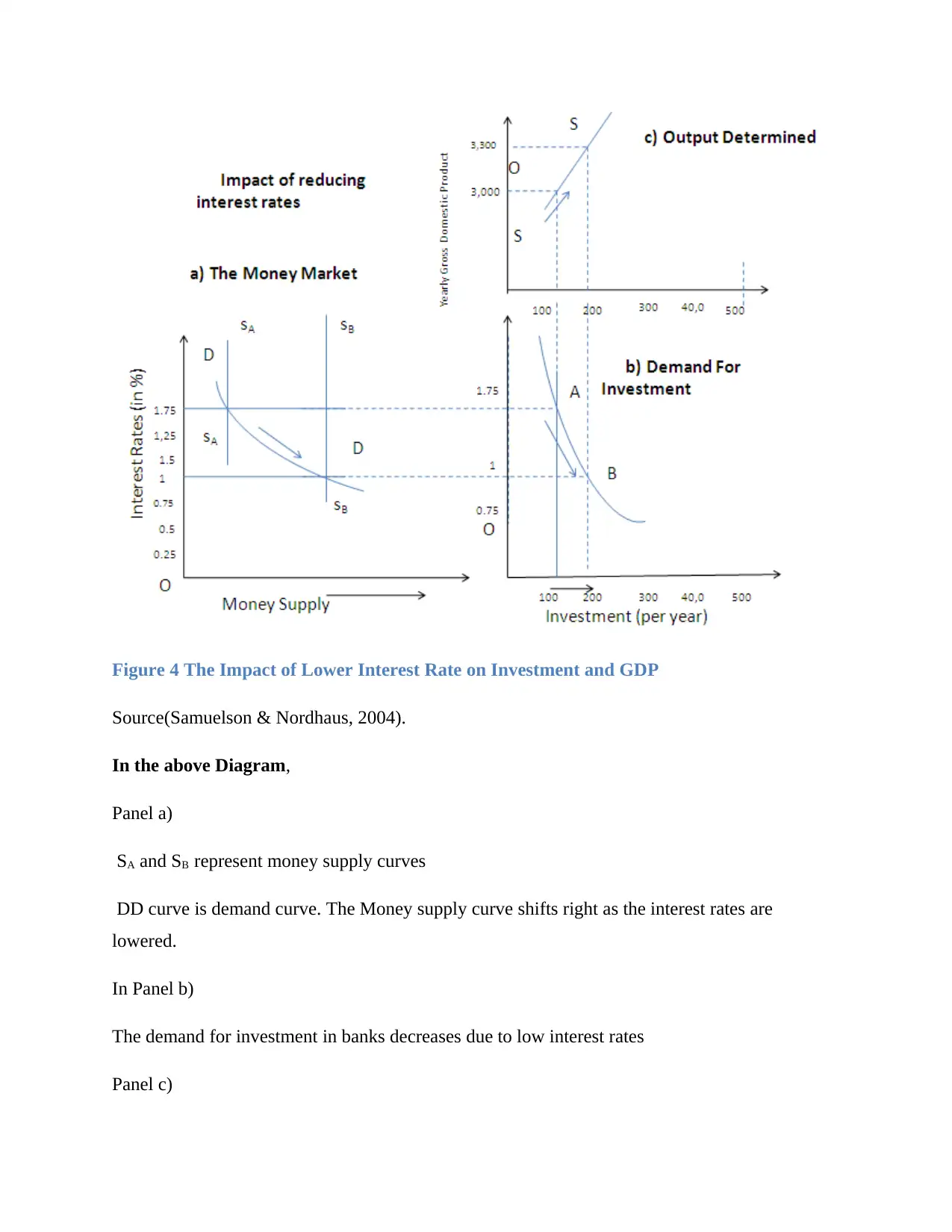
Figure 4 The Impact of Lower Interest Rate on Investment and GDP
Source(Samuelson & Nordhaus, 2004).
In the above Diagram,
Panel a)
SA and SB represent money supply curves
DD curve is demand curve. The Money supply curve shifts right as the interest rates are
lowered.
In Panel b)
The demand for investment in banks decreases due to low interest rates
Panel c)
Source(Samuelson & Nordhaus, 2004).
In the above Diagram,
Panel a)
SA and SB represent money supply curves
DD curve is demand curve. The Money supply curve shifts right as the interest rates are
lowered.
In Panel b)
The demand for investment in banks decreases due to low interest rates
Panel c)

SS curve = Supply schedule
As seen in Panel A, as the Central Bank decreases the interest rates, there is an rise in money
supply from SA to SB . The increase in money supply could be due to the fact that it is not
profitable for investors and consumers to hold cash balances in the bank any more.
In Panel B, the effects of a decrease in interest rate are shown on investment, since lower interest
rates are an incentive for business owners to borrow money. The Investment at an index of 100
and has shifted to 200. These investments would generally, result in investments in equipment
and production capacity of plant.
The Crisis forced the governments world wise, especially in the USA to adopt near zero Short Term
Interest rates and help increase the money supply within the economy by way of quantitative easing.
(Tyson, 2013)
References
Auerbach, A. J. (2009, February). Fiscal Policy in recession, US Fiscal Policy in Recession: What is next?
Retrieved Januaury 31, 2018, from CESifo Forum: https://www.cesifo-group.de/DocDL/forum2-
09-focus1.pdf
Board of Governors of the Federal Reserve System. (2018, April 18). Fred Economic Data. Retrieved from
Federal Reserve Bank of St. Louis: https://fred.stlouisfed.org/search?
st=Current+Account+Deficit+China
Bradsher, K. (2011, August 8). Chinese Fault Beijing Over Foreign Reserves. Retrieved from The New York
Times: https://www.nytimes.com/2011/08/09/business/global/chinese-fault-beijings-moves-on-
foreign-reserves.html
Bullard, J. (2017, December 1). Assessing the Risk of Yield Curve Inversion (Lecture). Little Rock, USA,
Arkansas: Federal Reserve Bank of St. Louis.
Cherunilam, F. (2005). International Business: Texts and Cases. New Delhi: Prenctice Hall of India.
Evans-Pritchard, A. (2009, May 06). China fears bond crisis as it slams quantitative easing. Retrieved
from The Telegraph: https://www.nytimes.com/2011/08/09/business/global/chinese-fault-
beijings-moves-on-foreign-reserves.html
International Monetary Fund. (2017). REER is the nominal effective exchange rate (a measure of the
value of a currency against a weighted average of several foreign currencies) divided by a price
deflator or index of costs. Retrieved September 6, 2017, from International Monetary Fund:
As seen in Panel A, as the Central Bank decreases the interest rates, there is an rise in money
supply from SA to SB . The increase in money supply could be due to the fact that it is not
profitable for investors and consumers to hold cash balances in the bank any more.
In Panel B, the effects of a decrease in interest rate are shown on investment, since lower interest
rates are an incentive for business owners to borrow money. The Investment at an index of 100
and has shifted to 200. These investments would generally, result in investments in equipment
and production capacity of plant.
The Crisis forced the governments world wise, especially in the USA to adopt near zero Short Term
Interest rates and help increase the money supply within the economy by way of quantitative easing.
(Tyson, 2013)
References
Auerbach, A. J. (2009, February). Fiscal Policy in recession, US Fiscal Policy in Recession: What is next?
Retrieved Januaury 31, 2018, from CESifo Forum: https://www.cesifo-group.de/DocDL/forum2-
09-focus1.pdf
Board of Governors of the Federal Reserve System. (2018, April 18). Fred Economic Data. Retrieved from
Federal Reserve Bank of St. Louis: https://fred.stlouisfed.org/search?
st=Current+Account+Deficit+China
Bradsher, K. (2011, August 8). Chinese Fault Beijing Over Foreign Reserves. Retrieved from The New York
Times: https://www.nytimes.com/2011/08/09/business/global/chinese-fault-beijings-moves-on-
foreign-reserves.html
Bullard, J. (2017, December 1). Assessing the Risk of Yield Curve Inversion (Lecture). Little Rock, USA,
Arkansas: Federal Reserve Bank of St. Louis.
Cherunilam, F. (2005). International Business: Texts and Cases. New Delhi: Prenctice Hall of India.
Evans-Pritchard, A. (2009, May 06). China fears bond crisis as it slams quantitative easing. Retrieved
from The Telegraph: https://www.nytimes.com/2011/08/09/business/global/chinese-fault-
beijings-moves-on-foreign-reserves.html
International Monetary Fund. (2017). REER is the nominal effective exchange rate (a measure of the
value of a currency against a weighted average of several foreign currencies) divided by a price
deflator or index of costs. Retrieved September 6, 2017, from International Monetary Fund:
Paraphrase This Document
Need a fresh take? Get an instant paraphrase of this document with our AI Paraphraser
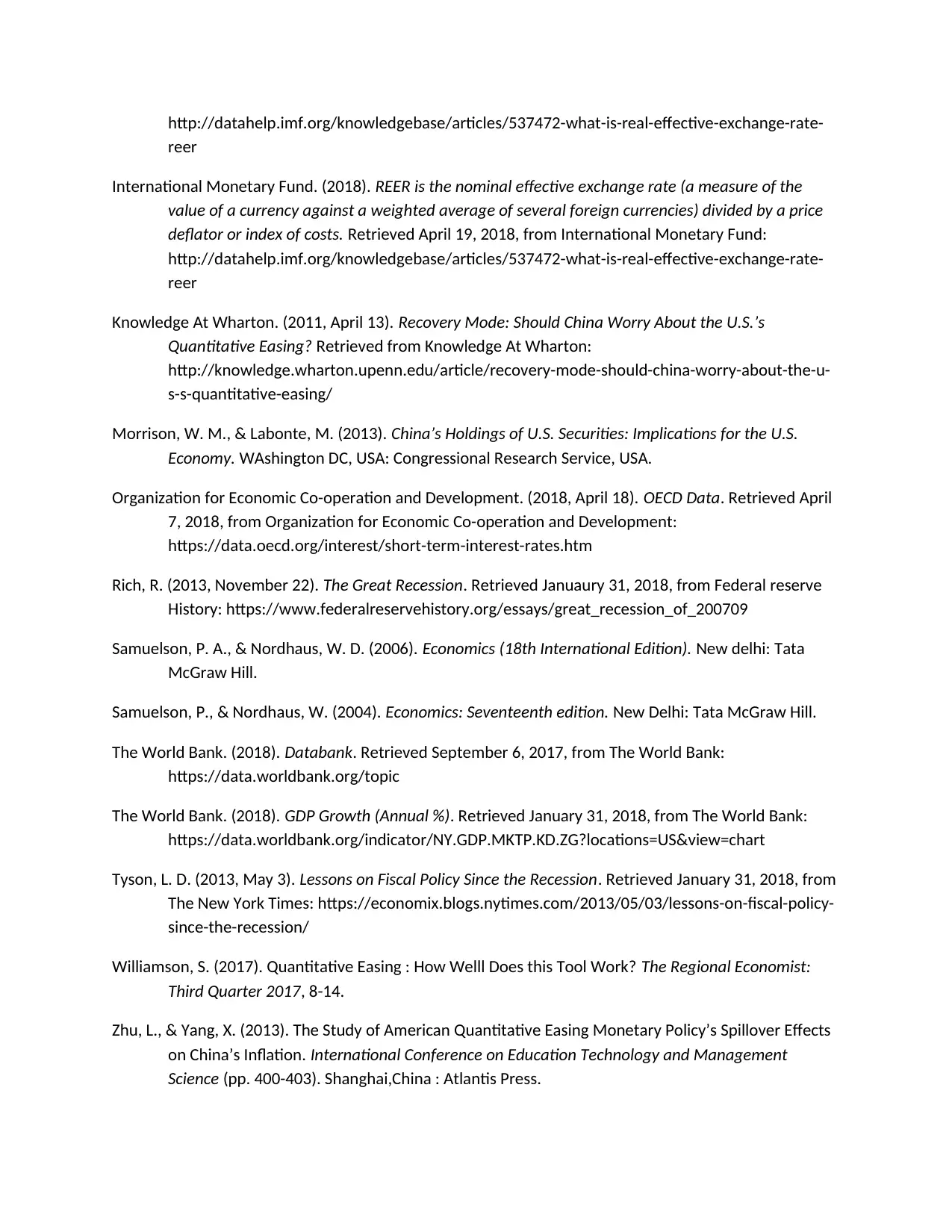
http://datahelp.imf.org/knowledgebase/articles/537472-what-is-real-effective-exchange-rate-
reer
International Monetary Fund. (2018). REER is the nominal effective exchange rate (a measure of the
value of a currency against a weighted average of several foreign currencies) divided by a price
deflator or index of costs. Retrieved April 19, 2018, from International Monetary Fund:
http://datahelp.imf.org/knowledgebase/articles/537472-what-is-real-effective-exchange-rate-
reer
Knowledge At Wharton. (2011, April 13). Recovery Mode: Should China Worry About the U.S.’s
Quantitative Easing? Retrieved from Knowledge At Wharton:
http://knowledge.wharton.upenn.edu/article/recovery-mode-should-china-worry-about-the-u-
s-s-quantitative-easing/
Morrison, W. M., & Labonte, M. (2013). China’s Holdings of U.S. Securities: Implications for the U.S.
Economy. WAshington DC, USA: Congressional Research Service, USA.
Organization for Economic Co-operation and Development. (2018, April 18). OECD Data. Retrieved April
7, 2018, from Organization for Economic Co-operation and Development:
https://data.oecd.org/interest/short-term-interest-rates.htm
Rich, R. (2013, November 22). The Great Recession. Retrieved Januaury 31, 2018, from Federal reserve
History: https://www.federalreservehistory.org/essays/great_recession_of_200709
Samuelson, P. A., & Nordhaus, W. D. (2006). Economics (18th International Edition). New delhi: Tata
McGraw Hill.
Samuelson, P., & Nordhaus, W. (2004). Economics: Seventeenth edition. New Delhi: Tata McGraw Hill.
The World Bank. (2018). Databank. Retrieved September 6, 2017, from The World Bank:
https://data.worldbank.org/topic
The World Bank. (2018). GDP Growth (Annual %). Retrieved January 31, 2018, from The World Bank:
https://data.worldbank.org/indicator/NY.GDP.MKTP.KD.ZG?locations=US&view=chart
Tyson, L. D. (2013, May 3). Lessons on Fiscal Policy Since the Recession. Retrieved January 31, 2018, from
The New York Times: https://economix.blogs.nytimes.com/2013/05/03/lessons-on-fiscal-policy-
since-the-recession/
Williamson, S. (2017). Quantitative Easing : How Welll Does this Tool Work? The Regional Economist:
Third Quarter 2017, 8-14.
Zhu, L., & Yang, X. (2013). The Study of American Quantitative Easing Monetary Policy’s Spillover Effects
on China’s Inflation. International Conference on Education Technology and Management
Science (pp. 400-403). Shanghai,China : Atlantis Press.
reer
International Monetary Fund. (2018). REER is the nominal effective exchange rate (a measure of the
value of a currency against a weighted average of several foreign currencies) divided by a price
deflator or index of costs. Retrieved April 19, 2018, from International Monetary Fund:
http://datahelp.imf.org/knowledgebase/articles/537472-what-is-real-effective-exchange-rate-
reer
Knowledge At Wharton. (2011, April 13). Recovery Mode: Should China Worry About the U.S.’s
Quantitative Easing? Retrieved from Knowledge At Wharton:
http://knowledge.wharton.upenn.edu/article/recovery-mode-should-china-worry-about-the-u-
s-s-quantitative-easing/
Morrison, W. M., & Labonte, M. (2013). China’s Holdings of U.S. Securities: Implications for the U.S.
Economy. WAshington DC, USA: Congressional Research Service, USA.
Organization for Economic Co-operation and Development. (2018, April 18). OECD Data. Retrieved April
7, 2018, from Organization for Economic Co-operation and Development:
https://data.oecd.org/interest/short-term-interest-rates.htm
Rich, R. (2013, November 22). The Great Recession. Retrieved Januaury 31, 2018, from Federal reserve
History: https://www.federalreservehistory.org/essays/great_recession_of_200709
Samuelson, P. A., & Nordhaus, W. D. (2006). Economics (18th International Edition). New delhi: Tata
McGraw Hill.
Samuelson, P., & Nordhaus, W. (2004). Economics: Seventeenth edition. New Delhi: Tata McGraw Hill.
The World Bank. (2018). Databank. Retrieved September 6, 2017, from The World Bank:
https://data.worldbank.org/topic
The World Bank. (2018). GDP Growth (Annual %). Retrieved January 31, 2018, from The World Bank:
https://data.worldbank.org/indicator/NY.GDP.MKTP.KD.ZG?locations=US&view=chart
Tyson, L. D. (2013, May 3). Lessons on Fiscal Policy Since the Recession. Retrieved January 31, 2018, from
The New York Times: https://economix.blogs.nytimes.com/2013/05/03/lessons-on-fiscal-policy-
since-the-recession/
Williamson, S. (2017). Quantitative Easing : How Welll Does this Tool Work? The Regional Economist:
Third Quarter 2017, 8-14.
Zhu, L., & Yang, X. (2013). The Study of American Quantitative Easing Monetary Policy’s Spillover Effects
on China’s Inflation. International Conference on Education Technology and Management
Science (pp. 400-403). Shanghai,China : Atlantis Press.

1 out of 21
Related Documents
Your All-in-One AI-Powered Toolkit for Academic Success.
+13062052269
info@desklib.com
Available 24*7 on WhatsApp / Email
![[object Object]](/_next/static/media/star-bottom.7253800d.svg)
Unlock your academic potential
© 2024 | Zucol Services PVT LTD | All rights reserved.





